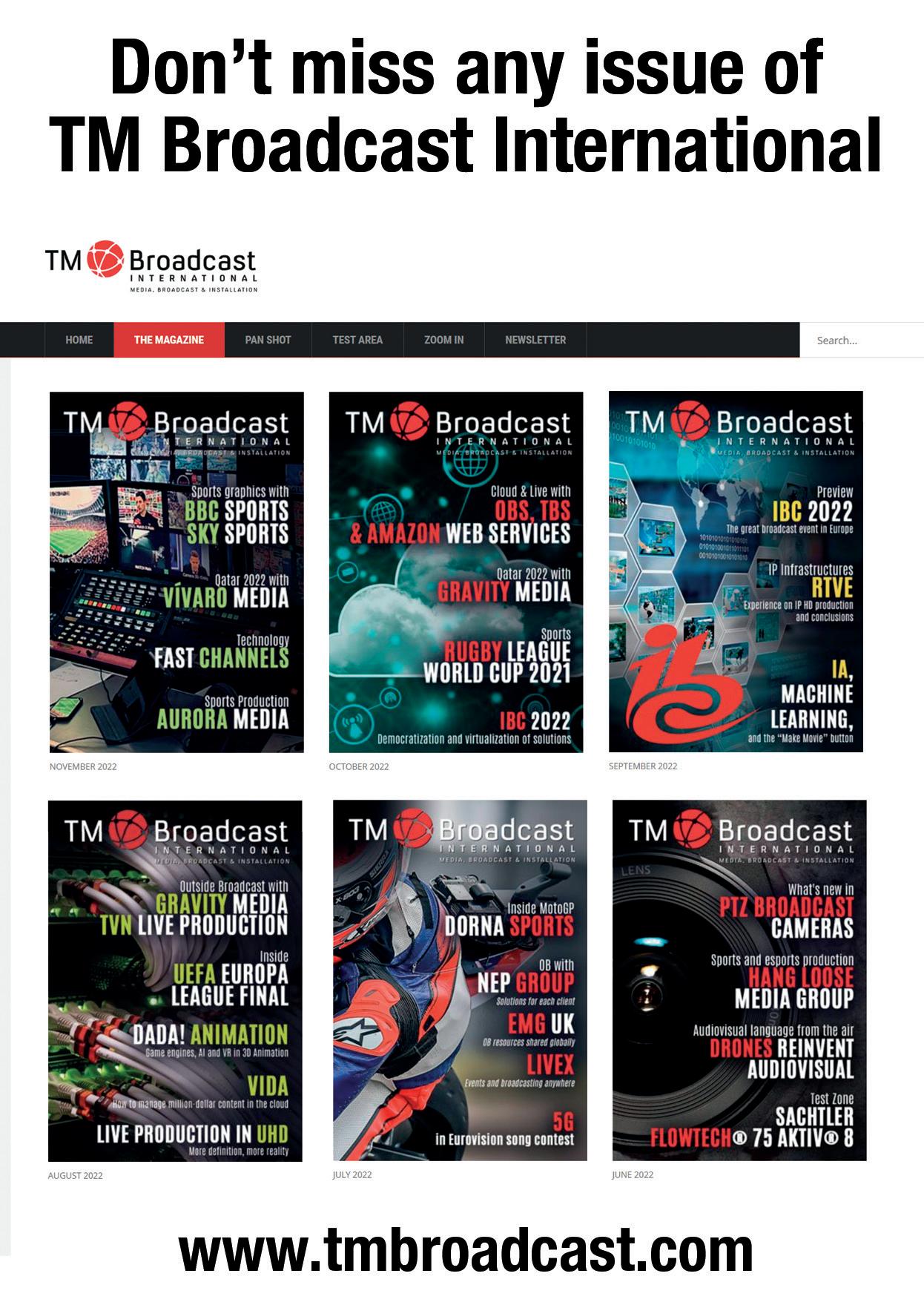




Broadcast industry is buzzing right now around the NAB Show upcoming and we understand it: at TM Broadcast’s redaction we are all excited anticipating all the new advancements in the broadcast and the audiovisual production landscape that we will find.
It’s because of this that we include in this issue a special article Pre-NAB 2024, in which we summarize the most interesting and promising developments that we can expect, according to the glimpses that companies have been seeding during last weeks.
Staying alive in these realms mean to keep up with technologies and consumers’ behaviour; this is the key energy beneath the new European Broadcasting Union’s ambitious venture, Eurovision Sport. This groundbreaking platform is set to redefine free-to-air sports broadcasting by leveraging innovative technologies and partnerships. Our exclusive interview with Jean-Baptiste Casta, Head of Strategy & Business Operations at Eurovision Sport, unveils the challenges, strategies, and visions that have culminated in the creation of an OTT designed to complement traditional broadcasting and bring sports to fans in

unprecedented ways. And it’s free, which highlight the EBU’s vocation of service.
For that technician in everyone, we not only include a special report about Robotic Camera Systems, but this issue also delves into the realm of UHD. Through an in-depth article, TM Broadcast demystifies what UHD truly represents beyond just a leap in resolution. Through expert insights and a thorough examination of industry standards, we unravel the complexities and nuances of UHD broadcasting. From the wider color gamuts and high dynamic ranges to the advancements in audio and frame rates, our coverage provides a holistic understanding of how UHD is setting new benchmarks in the quality of broadcast contents.
In this edition, our mission is to not only inform but also inspire our readers. By highlighting these pivotal developments, we aim to foster a deeper appreciation for the technological marvels at play behind the scenes of your favorite broadcasts. We invite you, reader, to join us in exploring these themes and issues, as we continue searching for what’s possible in the world of broadcast and audiovisual production.
In this special Pre NAB Show 2024, the reader will find a guide that aims to serve as a compass for visitors to one of the most representative meetings of the broadcast industry and the creation, production and distribution of audiovisual content.
The beginning of the year saw a milestone in the Spanish audiovisual sector: the transition of all terrestrial broadcasting to HD. The wrongly so-called ‘analogue blackout’ -nor that SD DTT was analogue, anyway- has also driven public broadcaster RTVE to finally begin permanent broadcasting in UHD. And if from SD to HD we have no doubts, -as resolution was multiplied by four- the move to UHD can be a little more awkward.


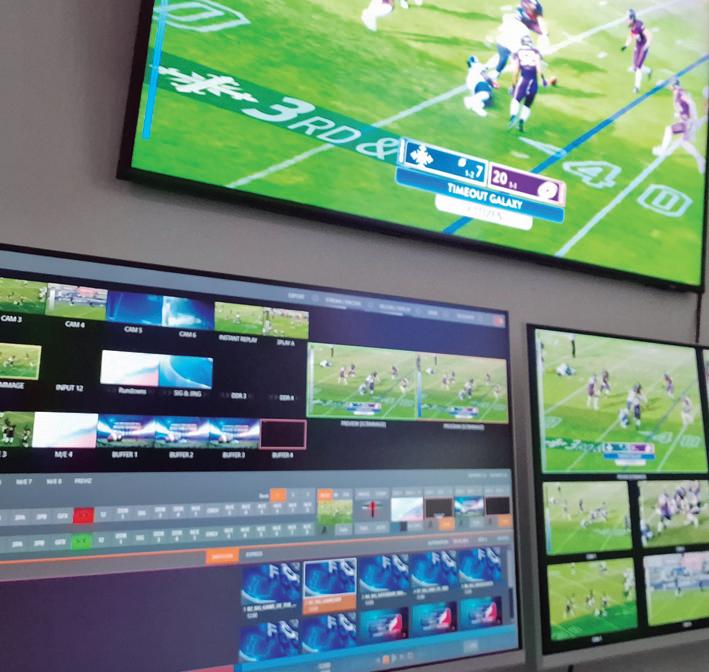
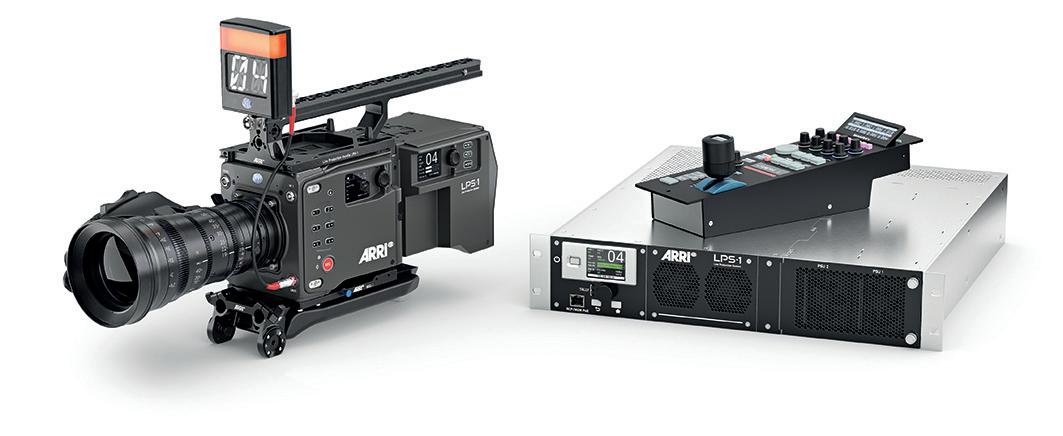
The system seamlessly integrates into existing live production environments, providing the full functionality of a system camera while retaining the flexibility of a dockable camera setup. It sits alongside ARRI lenses, lights, stabilizers, and custom solutions that collectively demonstrate the company’s commitment to the live entertainment sector.
This new system combines the new ALEXA 35 Live camera, the new Live Production System LPS-1 (comprising a Fiber Camera Adapter and Fiber Base Station), the Skaarhoj RCP, and a slew of bespoke accessories. These include the new ARRI Touchdown base and receiver plates, an adjustable monitor yoke, an extra-long camera handle, a tally light with camera ID display, a rain cover, and a new, quick-fit ARRI Large Lens Adapter for unprecedentedly rapid setup with box lenses.
The ALEXA 35 Live camera supports the Super 35-sized 4K
sensor enables shallow depth of field. Capturing 17 stops of dynamic range it handles extreme lighting situations for the best results in SDR and HDR.
Full-quality ProRes can be recorded in-camera during live productions, providing flexibility in post. The in-camera recording also permits stand-alone operation of the camera, without the Fiber Camera Adapter. The modular lens mount can be switched between LPL, PL, EF, and B4, facilitating a wide choice of lenses for different applications. ALEXA 35 Live owners can even upgrade to full ALEXA 35 functionality via an optional Cine License.
ARRI Look Files can define a unique image character through specially developed Multicam Looks. One of 87 pre-made looks from the built-in ARRI Look Library can be activated at the push of a button, catering to a huge variety of shooting scenarios. Secondly, ARRI
Textures are a unique method to modify grain and contrast. The camera includes five multicam and eight cine-style ARRI Textures.
The Fiber Camera Adapter of the ALEXA 35 Live - Multicam System attaches to the camera quickly and easily, while the Fiber Base Station integrates seamlessly into the engineering room or OB vehicle, supporting multiple simultaneous outputs such as HD, UHD, progressive, or interlaced video.
Connecting them is a SMPTE 311 hybrid fiber cable that includes copper connections to supply up to 400 W of power for the camera and accessories. The hybrid cable also allows uncompressed 4K video transmission over a distance of up to 2 km. Tactical fiber cable lengths of up to 10 km can be used if the camera is powered locally. An additional extra fiber tunnel and Ethernet tunnel increase the system’s flexibility.
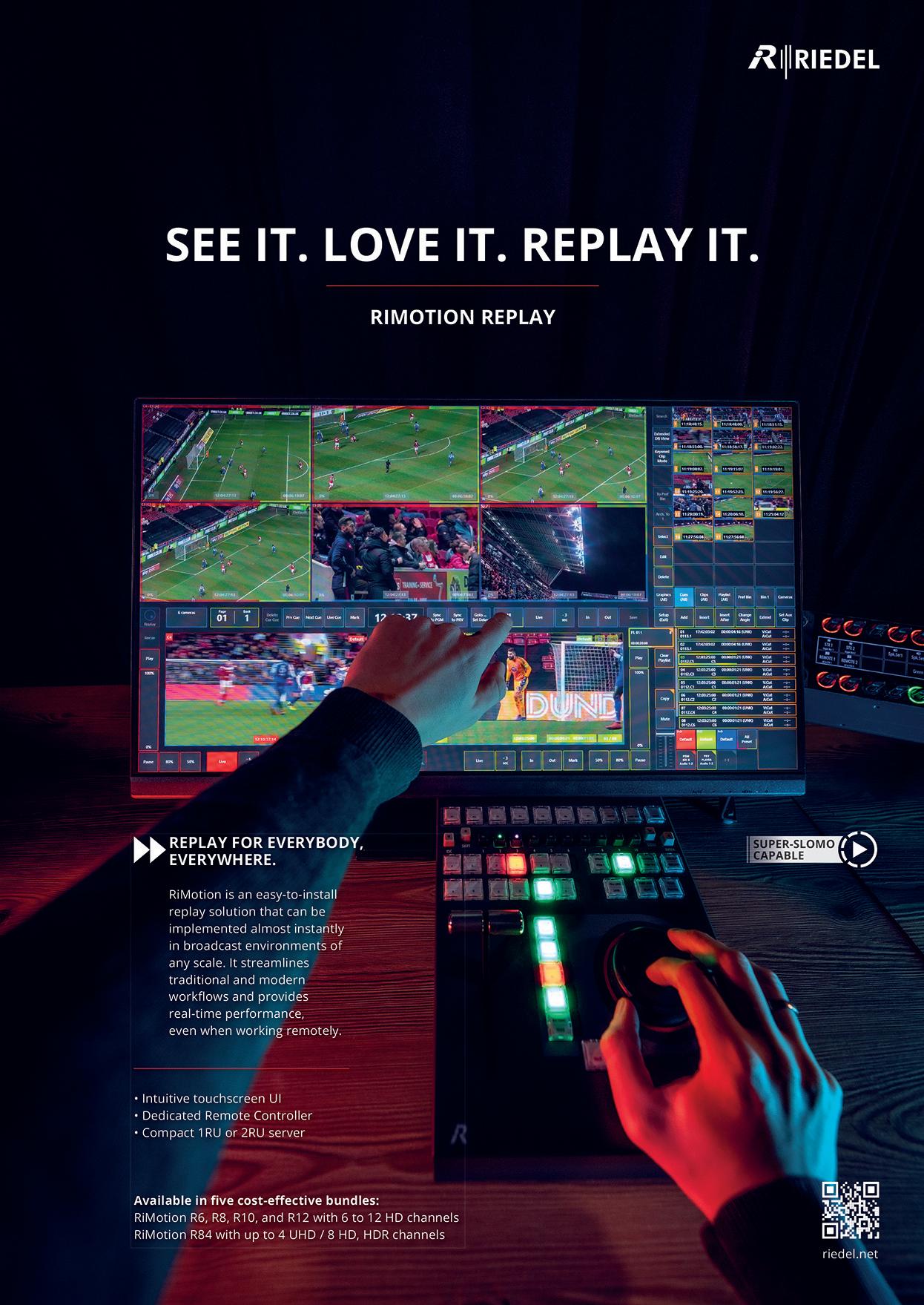
In a groundbreaking virtual event, Lawo has revealed the HOME mc² DSP app’s introduction, a microservice-based counterpart to Lawo’s A__UHD Core. Joining the HOME Apps family, the ultra-low-latency HOME mc² DSP app stands as a server-based, agile audio engine. Seamlessly blending the familiarity of the HOME Apps platform with Lawo’s signature audio processing excellence, it offers superior flexibility in connectivity and scalability.
Designed to be used in conjunction with mc² mixing consoles or to create a (virtual) mixing system instantly, the HOME mc² DSP app meets the demands of audio processing wherever and whenever it’s needed at short notice.
The brand new solution is the go-to audio processing solution for converged video/ audio production environments. Packing all the features of the A__UHD Core FPGA processing platform into a CPU-based package, it enables operators to deploy mc²-grade DSP processing with unprecedented granularity.
As part of the HOME Apps platform, the new app benefits from the agility provided by processing abstraction from

hardware. Leveraging Lawo’s Flex licensing and subscription model, users can allocate subscription credits to any available HOME App, whether audio or video, for precise budget control. Transitioning from one location, such as the production hub, to another, like an OB truck or remote site, is seamless.
The primary role of this new tool is to deliver audio processing in scenarios where an A__UHD Core isn’t accessible or where staying within the HOME Apps ecosystem is more practical. With this app, setting up a processing core with the required number of DSP channels for various use cases becomes effortless.
Despite its CPU-based architecture, the HOME mc² DSP app achieves the same ultra-low latency as its hardware counterpart. Its capabilities and characteristics are so akin that operators cannot discern whether they are using a hardware-based A__UHD Core or the mc² DSP app. Switching between the two—and back—is as easy as pushing a button in the HOME UI.
The application automatically scales with future CPU advancements and can deliver thousands of DSP channels when needed. Supporting mono, stereo, 5.1, and NGA Immersive Mixing formats, as well as a flexible number of AUX, GRP, and SUM busses, HOME mc² DSP embodies the app-based counterpart of the A__UHD Core. Any HOME App can be stopped at any time, freeing up server capacity, Flex Subscription credits, and reducing power consumption.
Christian Struck, Lawo’s Senior Product Manager, Audio Infrastructure, commented: “HOME mc² DSP harnesses the unique granularity and flexibility of the HOME Apps platform regarding input and output media transport protocols. It will support mixed-format SMPTE ST2110, NDI, and SRT production environments, and newer formats that may become relevant down the line. There are no plans to discontinue the A__UHD Core as it remains the processing tool of choice for audio-only workflows in a livesound context.”

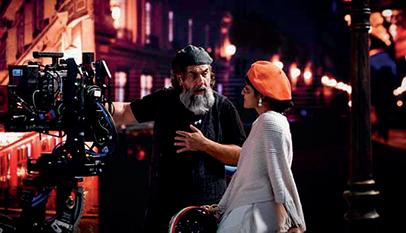
CABSAT, the premier event for content, broadcast, satellite, media, and entertainment in the Middle East, marks its 30th anniversary with its eagerly awaited comeback to the Dubai World Trade Centre from May 21st to 23rd, 2024. Also making a comeback is the second edition of the colocated event, Integrate Middle East, the leading forum and sourcing platform for the global Pro AV and media technology community, connecting industry leaders with integrated solution buyers from various sectors including education, media, entertainment, hospitality, retail, and communication.
Over the years, CABSAT has evolved to keep pace with the latest trends and technologies in the MEASA region. Organized by the Dubai World Trade Centre in collaboration with key stakeholders from the MEASA media industry, it features insightful presentations, panel
discussions, workshops, product demonstrations, and technology master classes, fostering a culture of knowledge exchange.
In 2024, the Middle East’s media and entertainment market is projected to reach USD 42.72 billion, with a projected CAGR of 9.41 percent, expected to reach USD 66.99 billion by 2029. The region continues to be a major destination for filmed content, broadcast, and satellite industries, transitioning significantly from a content consumption market to a content creation hub. CABSAT 2024 is poised to unveil the future of content creation and distribution, serving as a platform for the global media, entertainment, and technology industry, attracting participants from over 120 countries.
This year’s event promises to be exceptional, featuring the return of the Content Congress, providing opportunities to explore and share insights on the evolving media landscape; the SATEXPO Summit, facilitating innovation within the satellite and space community and fostering strategic partnerships;
and NextGen Content, offering a platform for the region’s best content creators, distributors, and investors. Additionally, exclusive spaces will be provided for engagement, discussion, and innovation within the creator economy and sustainable space utilization.
Integrate ME plays a crucial role in market growth
Following its successful debut in 2023, Integrate Middle East will once again bring together Pro AV and system integration tech leaders, attracting buyers from various sectors across the MENA region. The event will highlight the accelerated development of the Pro AV market, projected to reach USD 396.41 million by 2028, with a CAGR of 8.61 percent from 2024 to 2028. Factors contributing to this growth include increased use of digital signage, the popularity of e-learning, and technological advancements as noted in the Technavio Pro AV Market Analysis. Integrate Middle East will also shed light on advancements in the global smart buildings market, estimated to increase from USD 96 billion in 2023 to USD 408 billion by 2030, according to a report by Market Research Future.

AI-Media, a company specialized in end-to-end captioning technology solutions, has forged a strategic partnership with DAZN, the global sports entertainment streaming platform. This collaboration will see AI-Media providing live and recorded multilingual and translated captioning services using its AI-powered LEXI Tool Kit.
DAZN Group, renowned for its rapid growth in the sports media arena, views this partnership as a pivotal step towards enhancing inclusivity and accessibility in its content offerings. By leveraging AI-Media’s LEXI Tool Kit, DAZN aims to seamlessly integrate live captions across its vast array of premium sports content, enriching the viewing experience for millions worldwide.
Key aspects of this partnership include:
Cutting-Edge Technology: AI-Media’s latest automatic captioning solution, LEXI 3.0, incorporates innovative features like speaker identification and AI-powered caption placement, ensuring accuracy levels surpassing 98%. The tool’s advanced vocabulary adapts to region-specific nuances, enhancing the quality of sports content captioning.
End-to-End Solution: DAZN will deploy AI-Media’s Alta IP caption Encoder for LEXI Live captioning delivery. Alta offers a virtualized, API-powered software solution tailored for IP video environments, ensuring seamless integration.
Expanded Language Support: The initial rollout encompasses Spanish and English captions for EMEA and US markets, with plans for additional languages through LEXI Translate, covering French, German, Italian, Arabic, Japanese,
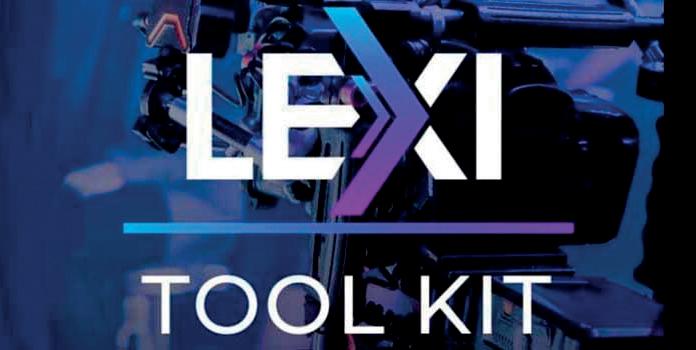
and more. This supports DAZN’s global expansion strategy across its 120 channels, catering to diverse audiences worldwide.
Support for On-Demand FAST
Channels: DAZN has integrated AI-Media’s LEXI Recorded solution for captioning pre-recorded content on their FAST (Free Ad-supported Streaming TV) Channels. This solution, a newly launched capability in the LEXI Tool Kit, offers fast turnaround, highly accurate, and cost-effective captions – crucial for high volume, time-sensitive captioning applications.
Cost-Effective Solution: Transitioning from expensive human captioning services to AI-Media’s LEXI platform enables DAZN to deliver multi-language captions across multiple channels at comparable costs, enhancing accessibility while optimizing resources.
Mark Lovatt, General Manager of Global Strategic Accounts at AI-Media, expressed excitement about the partnership: “With this new agreement, we’re thrilled to provide live and recorded multilingual captions to DAZN viewers using our LEXI Tool Kit solutions. Choosing AI-Media for LEXI automated captioning underscores the transformative impact of Artificial Intelligence on the industry.”
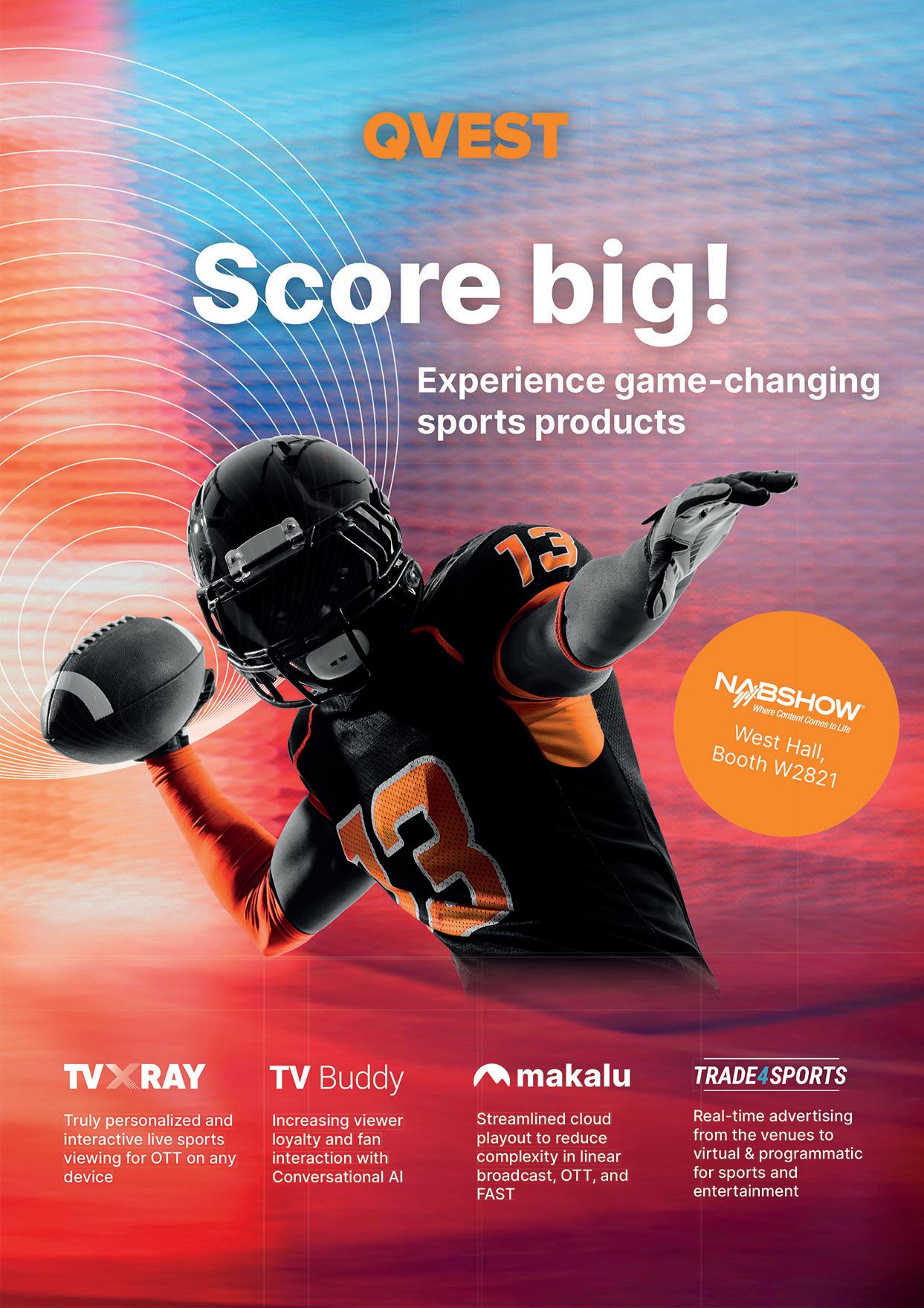
Pebble, specialized in automation, content management, and integrated channel solutions, has just announced a strategic collaboration with Nvidia. This partnership will see Pebble’s Prima platform seamlessly integrated with Nvidia Holoscan for Media, empowering Pebble’s clientele with enhanced media capabilities. The fruits of this collaboration will be showcased at the Pebble booth, West Hall, W3267, during the NAB Show 2024.
Prima, short for Platform for Real-Time Integrated Media Applications, stands as a cuttingedge Linux/Kubernetes-based software platform tailored to cater to the multifaceted needs of modern media and broadcast organizations. Offering flexibility in deployment, top-tier security, economic scalability, and centralized management, Prima is engineered to adapt to the ever-evolving demands of media businesses.
On the other hand, Nvidia Holoscan for Media represents a neutral, adaptable, hybrid, IP-based platform architecture designed to facilitate the development and deployment of media applications. This open-source platform adheres to industry standards and APIs, including SMPTE ST 2110, AMWA NMOS, RIST, SRT, and NDI.
Under Nvidia’s early-access

program for Holoscan for Media, Prima will initially support a core set of applications, including playout, workflow, and IP management and control. These applications complement Pebble’s existing suite of marketleading playout solutions, expanding their functionalities.
Daniel Robinson, Pebble’s Head of Product, elaborates, “By embracing Nvidia Holoscan for Media, Pebble can introduce Prima into dynamic media facilities, in line with the EBU’s recommendations. This approach allows multiple media applications to operate on a shared compute platform, reducing administrative overheads, and maximizing resource utilization. Nvidia
Holoscan for Media also provides reference architectures for scalable Kubernetes environments, ensuring support for PTP, high-bandwidth networks, ST 2110, and GPUs.”
Guillaume Polaillon, Product Line Manager for Live Media Solutions at Nvidia, adds, “Broadcast and entertainment studios seek cutting-edge architectures that offer sustainability and cost-saving opportunities to meet their extensive media requirements. By leveraging Holoscan for Media, PRIMA brings these innovative solutions to fruition, offering enhanced scalability and security for media workflows, ushering in a new era of broadcast and media content.”


Leading the charge in real-time graphics and live production solutions for content creators, Vizrt unveils an elevated phase in its technical alliance with EVS, a global frontrunner in live video production solutions.
For years, the fusion of Vizrt’s flagship studio automation solution, Viz Mosart, with EVS XT and XS-series servers has empowered broadcasters with control and adaptability for seamless 24/7 playout operation.
Now, this support expands to include the XS-NEO, EVS’s software-defined server. In the company’s own words, building upon EVS’s legacy of speed and reliability, the XS-NEO introduces codec flexibility essential for modern news operations.
This fresh collaboration merges
Vizrt’s proficiency in automated production tools with EVS’s prowess in live broadcast technology, aiming to furnish a turnkey solution for both ingest and automation-driven playout. According to the product specifications, new XS-NEO server from EVS empowers broadcasters to seamlessly play multiple formats, including XDCam, and facilitates playback from local high-performance RAID disks or directly from a facility’s central storage, streamlining workflows for maximum efficiency.
“Viz Mosart remains at the forefront of automated multiformat live production, constantly evolving to meet industry demands. By integrating XS-NEO, we enhance our expertise in the software-defined newsroom,
providing unmatched flexibility for our customers’ workflows,” explains Andy Newton, Senior Product Manager at Vizrt.
Christophe Wittevrongel, Senior Solutions Manager at EVS, remarks, “As legacy ‘End of Life’ Ingest and Playout systems persist as a key challenge for newsrooms, having our softwaredefined XS-NEO fully validated for Viz Mosart control ensures smooth multi-format playout –including native XDCam support – directly within the News operation.”
He adds, “Our objective is to deliver a fully supported, hyperreliable ingest and playout solution that directly addresses one of the most critical aspects of Newsroom operation, seamlessly integrating with the existing infrastructure.”

Pioneering mediatech companies
Limecraft and OOONA have recently announced a collaboration that integrates Limecraft’s robust Media Intelligence into OOONA’s media localization platform.
Limecraft pioneered fully automated AI subtitling in the industry and has perfected its spotting algorithm over time.
According to the company, esteemed broadcasters and streaming platforms are already reaping significant time and cost benefits from its solution, enabling the creation of highquality subtitles from transcripts with a single button press.
As content producers generate ever-expanding volumes of
content and seek to broaden its reach, semi-automated processes have proven to be more efficient and cost-effective for subtitle production. Recent assessments indicate that the Limecraft and OOONA combination reduces subtitle creation time by up to 80%, both companies state.
“When we initially engaged with OOONA, we were on the verge of achieving a remarkable 2% error rate in dialogue accuracy,” remarks Maarten Verwaest, Limecraft’s co-founder. “Since then, we have surpassed that milestone, offering industryleading levels of accuracy and, consequently, efficiency. We are delighted that our solution is being integrated into the OOONA
toolkit, reaching an even broader user base. Customers shouldn’t have to grapple with the technical integration of individual applications. Both OOONA and Limecraft are dedicated to delivering seamless integration in terms of performance and user experience. By tackling technical complexities, we empower our users to focus on more creative endeavors.”
“We are constantly enhancing the automation capabilities in our toolkit,” states Alex Yoffe, OOONA Tools Product Manager. “Human language technologies play a pivotal role in this endeavor: speech recognition, machine translation, and synthetic voices, to name a few.”

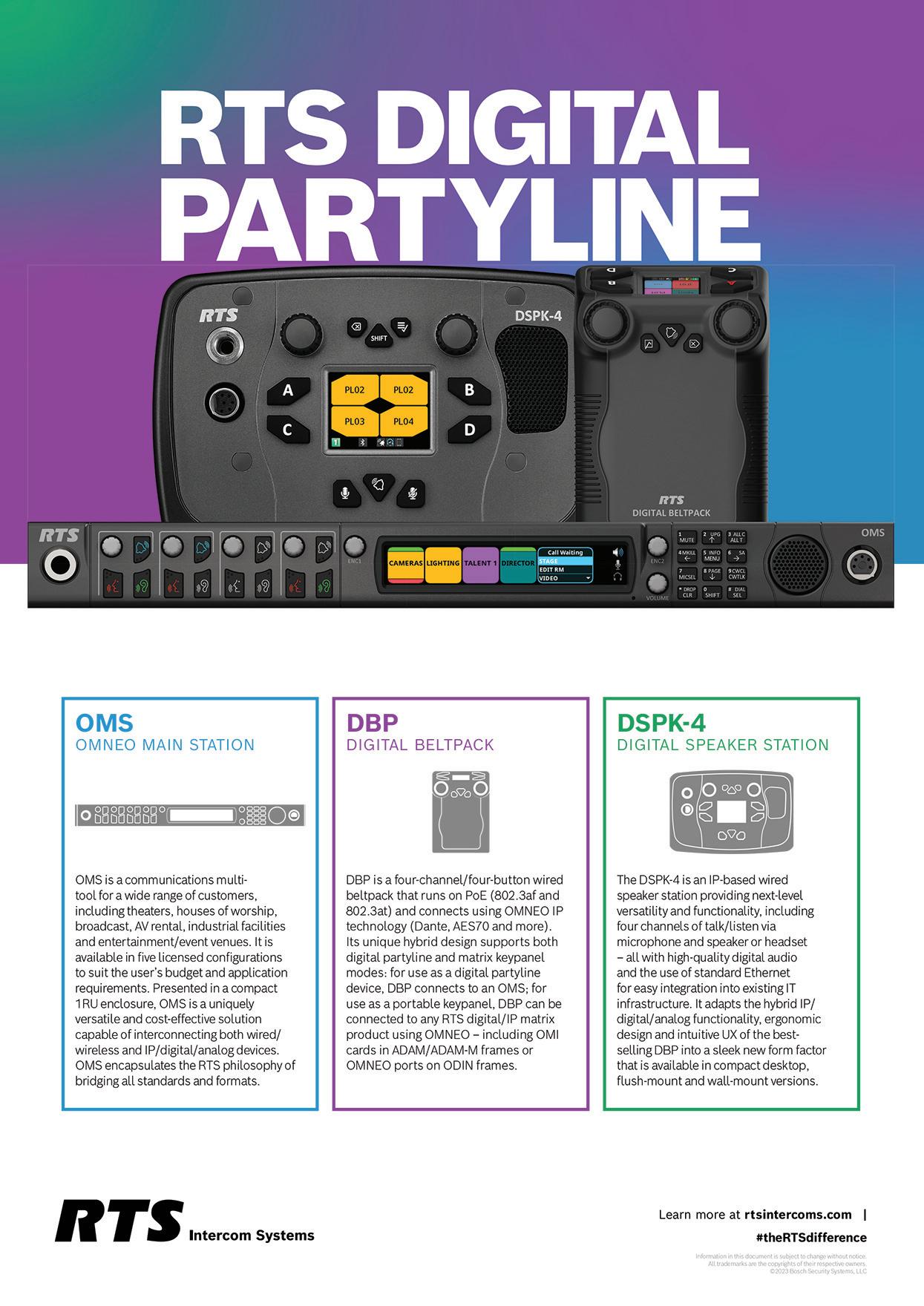
The long-term agreement provides TelevisaUnivision greater flexibility, scale, and intelligence in live video distribution with LTN’s fully managed, IP-based transmission solution, LTN Wave.
As part of the companies’ latest collaboration, TelevisaUnivision will utilize LTN Wave to deliver its full portfolio of 17 broadcast networks and cable channels via IP-based distribution, bringing a broad array of high quality live news, sports, and entertainment content to millions of viewers across the US, Mexico, and Puerto Rico. TelevisaUnivision serves approximately 60% of Spanish language linear viewership across US and Mexican markets and provides the largest dedicated Spanish language streaming service in the world, ViX. By embracing LTN Wave, TelevisaUnivision enables the seamless delivery of high value channels with over 260 drops to local affiliate stations and MVPDs, while supporting distribution across OTT, FAST, and other digital platforms.
“TelevisaUnivision has always pioneered emerging technologies to fuel long-term business objectives and better serve our growing audience,” said Ralf Jacob, EVP, Global Broadcast Engineering at TelevisaUnivison. “We’ve driven a number of IP-first initiatives across our organization to power more creativity and unlock more intelligent media distribution capabilities.
LTN is a trusted leader and innovator in the shift to more flexible IP-based options, and we’re excited to embark on our next phase of growth with a future-ready IP technology roadmap.”
Dalet has just announced the appointment of Santiago Solanas as its new Chief Executive Officer (CEO). With over three decades of experience at leading technology companies, including Cisco, Sage, Oracle, IBM, and Microsoft, Santiago brings a wealth of expertise to his new role. Most recently, he served as the CEO of PE-backed Grupo Primavera, where he played a pivotal role in the successful acquisition, integration, and advancement of 15 companies, culminating in the establishment of the foremost business management software platform in Iberia. This endeavor ultimately merged with Cegid, a PEbacked global provider of cloud business management solutions spanning finance, human resources, CPA’s, retail, and entrepreneurial sectors.

“Santiago’s appointment heralds an exciting new era for Dalet,” says Christian Heim, Chairman of the Board at Dalet and Partner at Long Path Partners (“LPP”). LPP spearheaded the privatization of Dalet in 2020 and remains the company’s controlling shareholder. “His remarkable track record of driving transformative growth and operational excellence perfectly complements Dalet’s legacy of innovation and leading-edge solutions. We are eager to support Dalet under Santiago’s leadership for the benefit of our esteemed customers, employees, and all stakeholders.”
As CEO, Santiago will uphold Dalet’s mission to be the preeminent leader in news, media & entertainment, and sports content solutions, leveraging advanced cloudnative, AI, and automation technologies. This commitment builds upon Dalet’s consistent, multi-year business momentum.
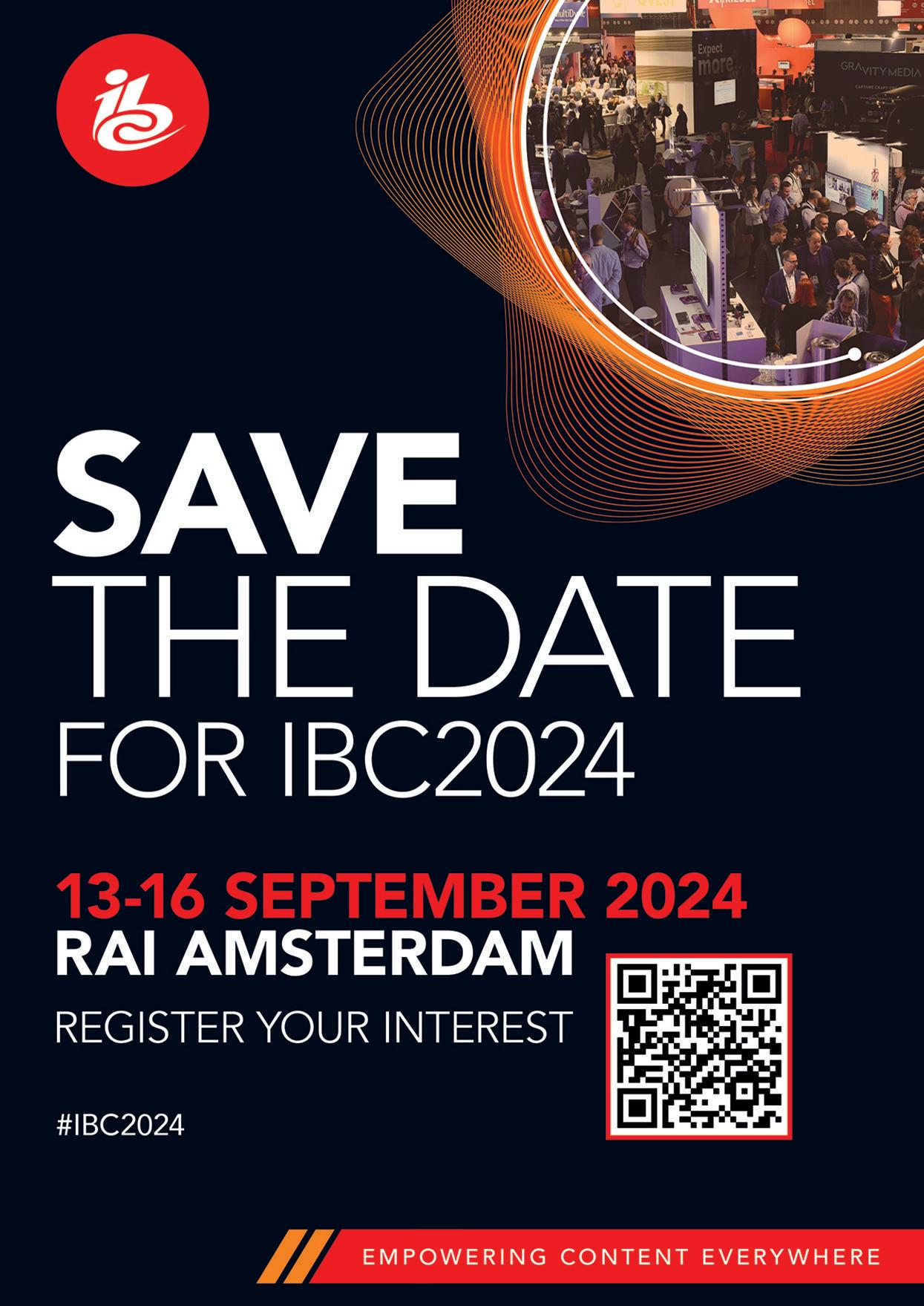

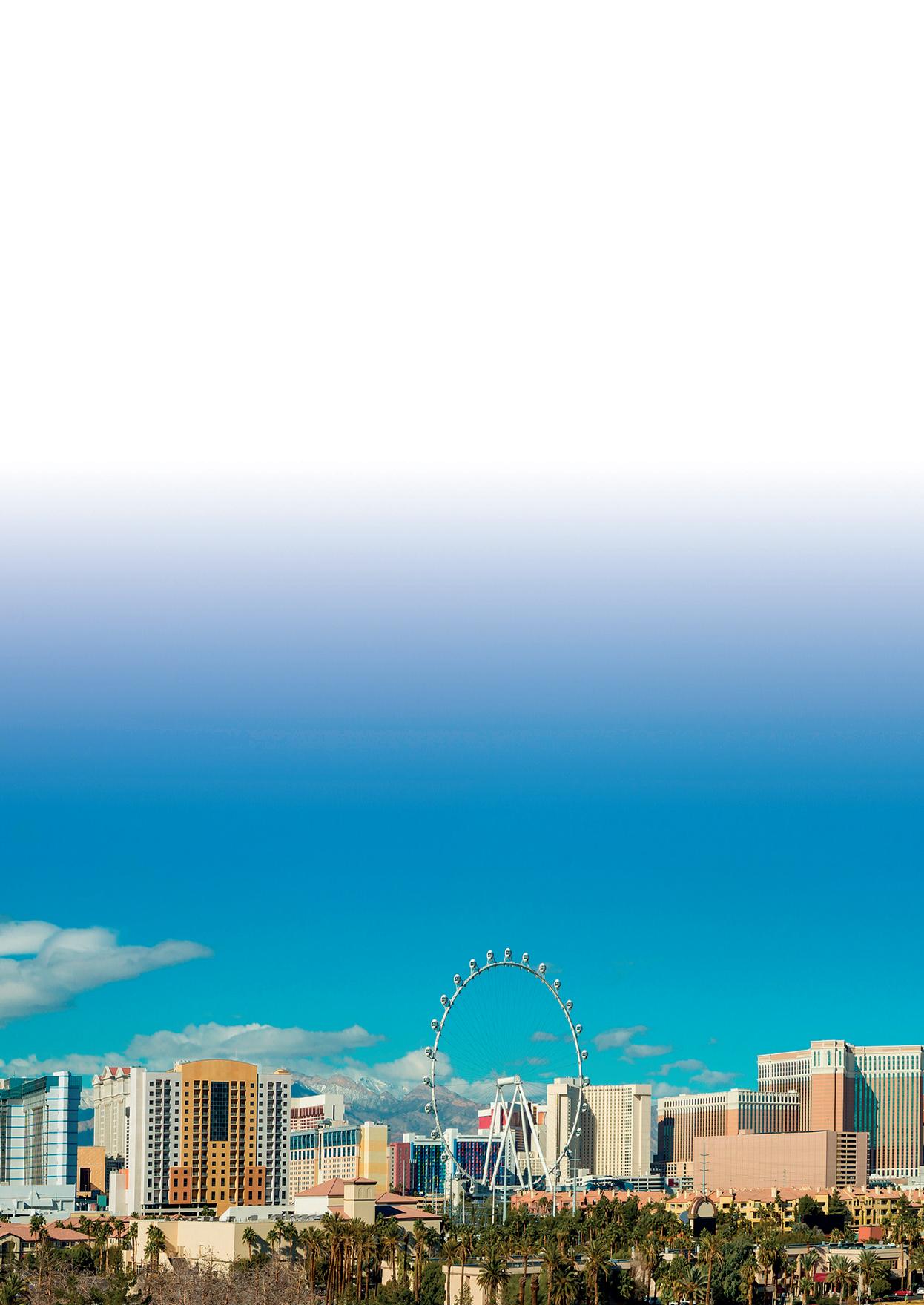
In this special Pre NAB Show 2024, the reader will find a guide that aims to serve as a compass for visitors to one of the most representative meetings of the broadcast industry and the creation, production and distribution of audiovisual content.
At TM Broadcast International we hope this guide will be useful when facing one of the most impacting events in the broadcast and content production sector. Here is what is expecting us at Las Vegas Convention Center, Paradise (Nevada) in April, from the 13th to the 17th.
AEQ will be showcasing its latest 2024 innovations, including:
- Solaris: audio gateway that integrates up to 64 stereo audiocodecs, available in a one-rack unit or on a dedicated/shared server, delivering audio over IP in AES67 or Dante formats.
- TP 9000 Series: new user panels for intercom systems with four-way toggle keys, available in rack and desktop formats.
- Olympia 3 System: a commentator system for large events that manages resources for large deployments of Olympia 3 commentator positions, with or without an audio matrix.
- Expanded functionality of Venus 4: The fourth generation IP audiocodec that provides point-to-point or multipoint connections with SIP and EBU N/ACIP standards.
- XPEAK: An intercom system prepared for remote production that
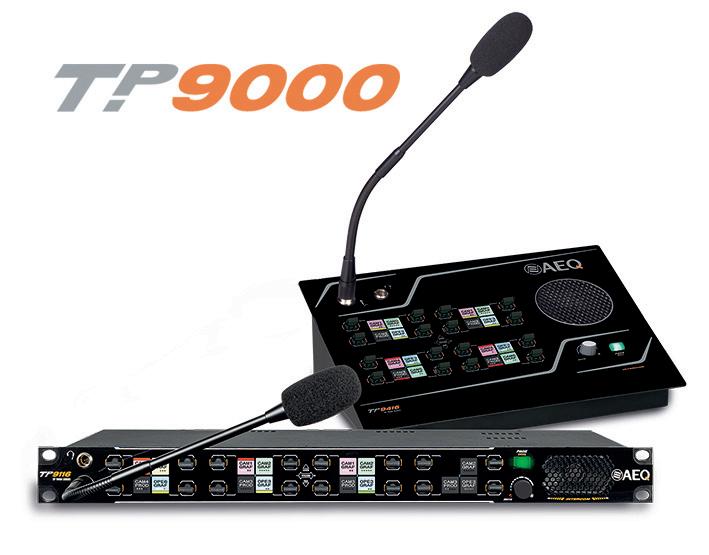
supports up to 28 user terminals without the need for a matrix.
Booth Location: C3106
Ateliere Creative Technologies will introduce its GenAI-driven media supply chain platform, showcasing the first GenAI module aimed at revolutionizing content workflow management. This innovative approach enhances ingest, management, distribution,
and monetization processes, reflecting Ateliere’s commitment to pushing the boundaries of conventional predictive AI applications.
Booth Location: W1343 S, AWS Partner Village
Appear will showcase live production technologies with the highest capacity accelerated SRT solution, unrivaled HEVC performance and flexibility, a new JPEG XS module, and a 100Gb IP Gateway switch module for increased live media throughput.

Will be showing:
Its LED Fresnels to the new L-Series Plus.
Booth Location: C6325
AWS will be showcasing:
Will be featuring demos tailored for Broadcast & Live Production, Monetization, Direct-toConsumer, Media Supply Chain & Archive, Data Science & Analytics, and Content Production, as well as its cloud-powered live newsroom production in collaboration with NVIDIA. Highlights include over 30 generative AI demonstrations and a live cloud-based news broadcast titled “Good Morning, NAB!”
Booth Location: W1701, West Hall
Blackmagic Design will be unveiling groundbreaking
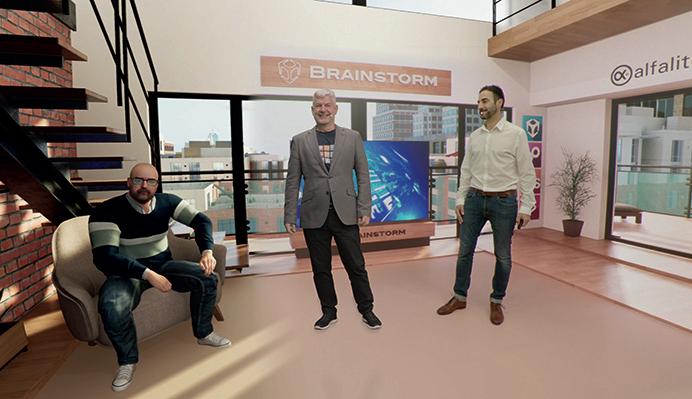
developments in camera technology. Attendees can look forward to the potential launch of a new full-frame 6K sensor camera in the URSA Mini Pro body, which may revolutionize highresolution imaging. The company is also anticipated to introduce CFexpress Type B card support across its camera lines. Besides, the company will potentially reveal enhancements to their Video Assist monitors and the latest version of DaVinci Resolve, and its support team will be available for all visitants.
Booth Location: SU3069
Brainstorm will unveil Suite 6 for eStudio, InfinitySet, and Aston, emphasizing advancements in Virtual Production and Real-time 3D Graphics. The showcase will feature an Elections program demonstration using Unreal Engine 5, highlighting InfinitySet’s capabilities with AR graphics and interactive elements. The collaboration with XD Motion will be displayed, demonstrating aerial filming and tracking integration. Additionally, Brainstorm will present new Dual-GPU capabilities for InfinitySet, offering enhanced control and efficiency in production workflows.
Booth Location: SL4097
Broadpeak will be showcasing:
Its comprehensive video streaming solutions and innovative targeted ad insertion technologies, designed to enhance quality of experience, boost monetization, and reduce costs for video service and content providers. Highlights


include interactive targeted ads that engage viewers directly and the Spot2Spot feature for more precise ad insertion within ad breaks.
Broadpeak’s end-to-end solution covers the entire video streaming workflow, demonstrating efficiency and cost reduction.
Booth location: W2529
Cleanfeed will be exhibiting:
Cleanfeed Cinema: brings together crystal clear audio with real-time high frame rate video streaming, tailored specifically for synchronous remote collaboration and audio production.
Booth Location: SU3055
Clear-Com will be exhibiting:
- Gen-IC Virtual Intercom: A cloud-powered intercom service offering scalable, versatile communication solutions for content creators and productions.
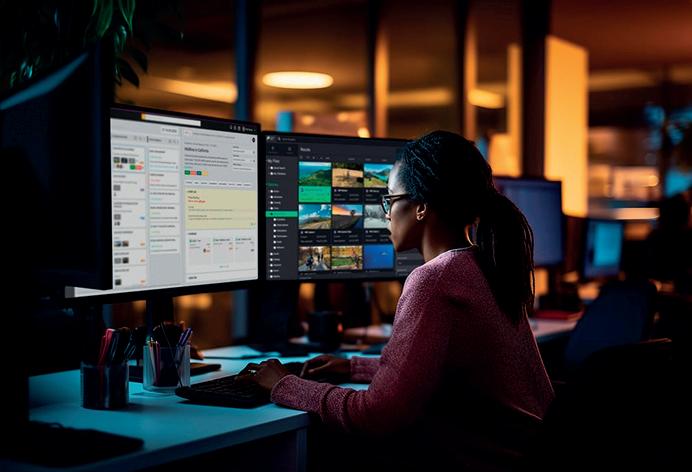
THE AWARD-WINNING DALET PYRAMID APPLICATION IS PRESENTED ALONGSIDE THE DALET CUT BROWSER-BASED EDITOR, AND DALET MEDIA CORTEX POWERFUL AI CAPABILITIES, WHICH PRESENT A REVOLUTIONARY APPROACH TO CENTRALIZED PLANNING AND MULTIFORMAT NEWS PRODUCTION ACROSS A GLOBAL NEWS ORGANIZATION. THE SHOWCASE WILL INCLUDE A PREVIEW OF NEXT-GENERATION, BROWSER-BASED RUNDOWN MANAGEMENT.
- Arcadia Central Station
- Eclipse HX 13.1 Enhancements
- EQUIP Wireless Intercom System
- HXII-DPL Powerline Device for HelixNet
Booth Location: C6007
Dalet will be showcasing:
AI-Enabled Collaborative Workflows: Utilizing a single cloud-native
technology stack, Dalet will demonstrate workflows that facilitate production, distribution, archive, and monetization across various channels for news, sports, and entertainment sectors.
Booth Location: W1713
Dear Reality will be demonstrating its spatial audio software solutions:
- dearVR PRO 2, the successor to its spatial audio plugin.
- dearVR Monitor plugin and other stereo mixing solutions.
Booth Location: 4732
Dejero will be demonstrating its EnGo 3x mobile video transmitter with GateWay mode and the GateWay 3220, to enhance mobile
production workflows by providing reliable internet connectivity anywhere.
The EnGo 3x, a 5G mobile transmitter, offers live video streaming and network aggregation for stable internet, supporting dataintensive applications and secure VPN access. The GateWay 3220, designed for critical mobile connectivity, ensures resilient internet access for field crews.
Booth location: SL9075
Innovations: Demonstrating the NEXX next-generation processing and routing solution, offering compact, versatile building blocks for transitioning to 12G-SDI and IP.
Booth Location: SU2027
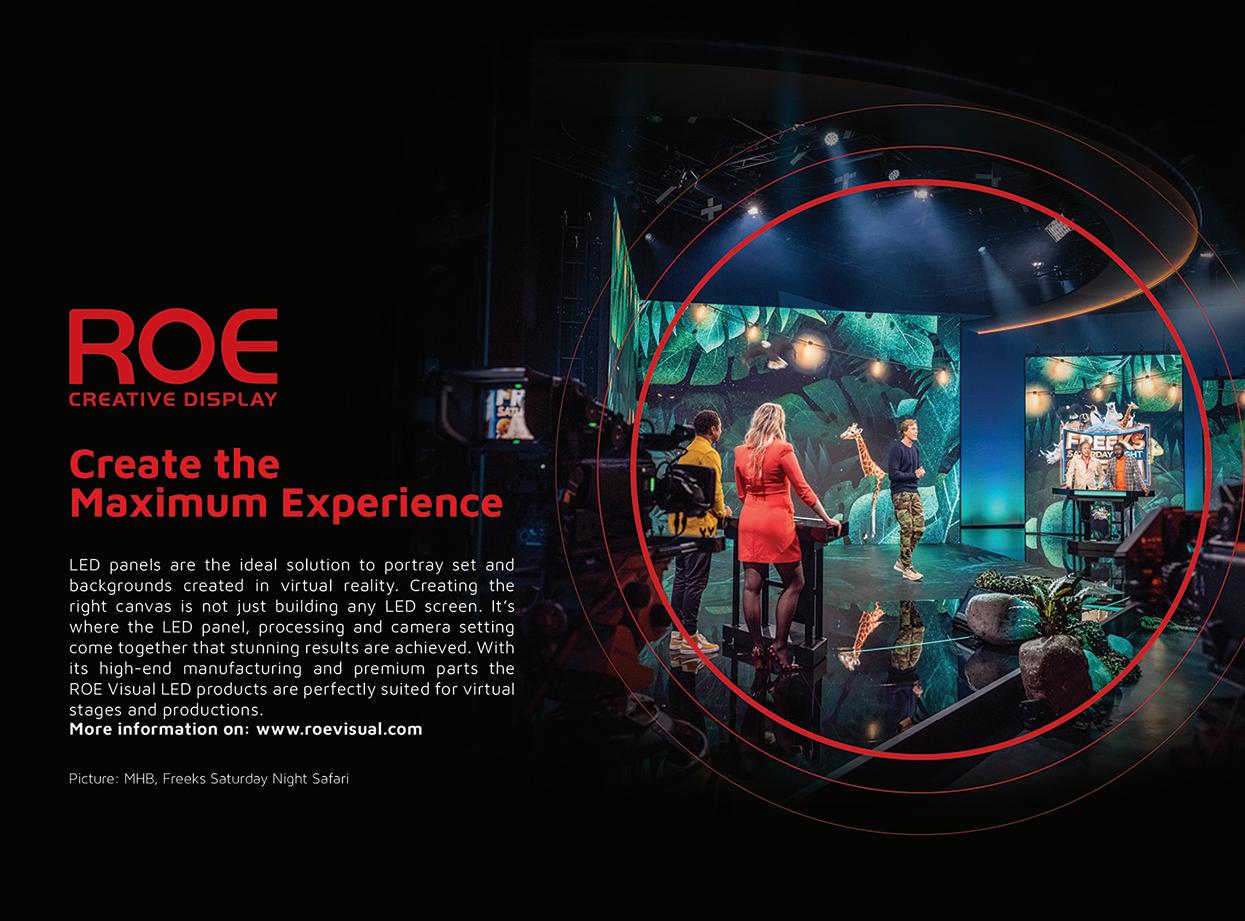
EVS is celebrating 30 years of innovation in live production at NAB 2024. As long as introducing a new licensing model for its flagship XT-VIA live production server, they’ll showcase their expertise in replays, highlights, content management, real-time processing, and video assistance for critical decision-making.
Booth Location: SU4015
farmerswife and Cirkus will be showcasing their latest project management solutions, including the innovative Public Requests feature for simplified project and booking submissions. The event will also introduce farmerswife 7.1, offering advancements in equipment tracking, scheduling, budgeting, and more for improved operational productivity.
Booth Location: W2267
Fujifilm will be unveiling innovative products, including the muchanticipated Fujinon Duvo 14-100mm PL Mount Zoom Lens. This marks the global debut of their third Duv Series lens, further expanding their robust lineup of cinema and broadcast solutions. Besides, the booth will feature a dynamic array of products for a handson experience, catering to professionals at every level.
Booth Location: C5325
GatesAir will be showcasing:
Flexiva GX2K: The latest addition to the Flexiva GX transmitter family, the GX2K model offers 2000 watts (2 kW) of analog FM power in a compact 2RU chassis.
GX50, GX1K, and GX3K Models: These transmitters maintain high overall efficiency across lower power levels and are designed with GatesAir’s third-generation
PowerSmart high-efficiency transmitter architecture.
Enhanced GUI and Features: Upgrade of the graphical user interface for all six GX models, integrating audio playback and a playlist manager.
Flexiva FAX and FMXi 4g: Low-power Flexiva FAX air-cooled transmitters and the FMXi 4g, an all-inone embedded HD Radio solution.
Booth Location: W2730
Grass Valley will be exhibiting: Launching the Maverik X software-based switcher/mixer powered by AMPP, supporting uncompressed and compressed inputs and outputs with full UHD HDR workflows.
Booth Location: C2308


Ikegami will be displaying its latest broadcast production cameras and monitors, including the UHK-X600, UHK-X700, UHK-X750, HDK99, UHL-43, and UHL-F4000 cameras, at NAB 2024. These offerings showcase advancements in 2160p 4K-UHD standards and feature enhancements like high frame rates, HDR, and IP connectivity.
Booth Location: C3819
Innovations: Showcasing innovations in Make TV and Monetize TV solutions, emphasizing flexible, converged architectures, and business models for sustainable growth.
Booth Location: West Hall, W2467
InterDigital will be showcasing:
Advanced HDR by Technicolor®: A suite of HDR solutions that
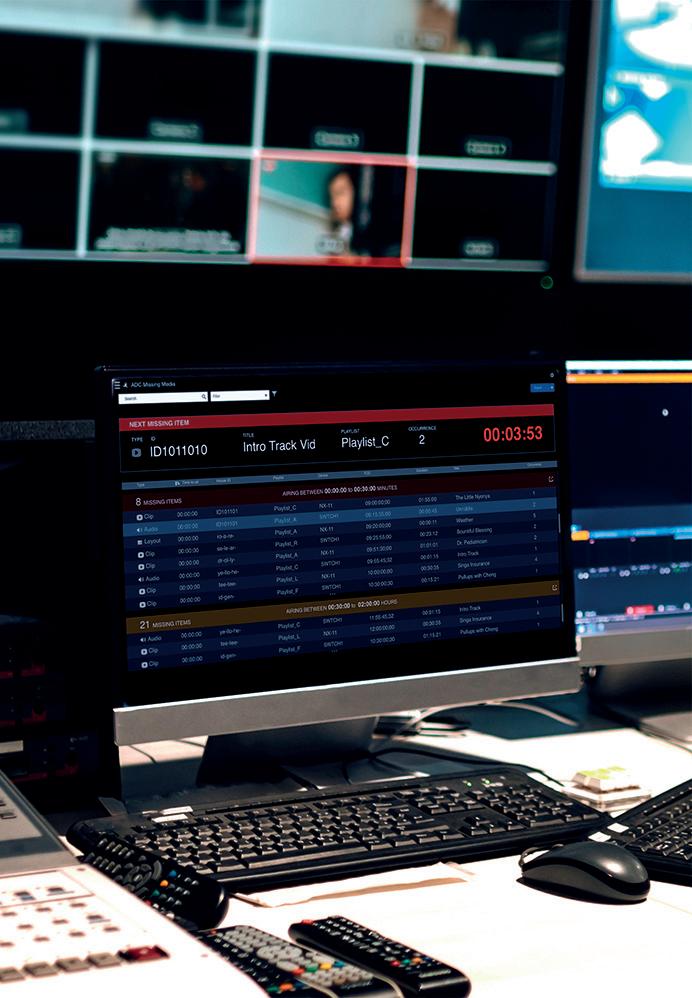
uses machine learning to maximize image quality for video streaming services, supporting efficient HDR content distribution.
Sustainable Streaming
Solutions: for the delivery of Ultra HD content, including pixel value reduction in HDR content and energyefficient media streaming technologies.
Booth Locations: ATSC booth at W3056, Ultra HD Forum booth at W4007, and Advanced HDR by Technicolor Meeting Room at W2476.
Interra will be showcasing:
-BATON Captions: advanced machine learning and ASR technology for automated captioning, addressing generation, comprehensive QC, correction, and localization for global media distribution.
Enhancements include web-based player support, on-prem translation for 108 languages, SAML integration, and timestamping support.
- ORION Content
Monitoring: for OTT, linear/ IP video, and hybrid cloud deployments, now with localization certification, Dolby Atmos support, and SAML-based SSO.
Enhancements include dynamic ad insertion monitoring and low-latency stream support.
- ORION 2110 Probe: Supports SMPTE ST 2110 standard for IP environments, providing end-to-end video quality monitoring.
- ORION Central Manager
(OCM): With new features for ad insertion monitoring and user group permissions for access control.
Booth Location: West Hall, W2720
intoPIX will be showcasing its latest in JPEG XS technology offering efficient video workflows with optimal latency and quality. Their solutions enhance LAN, WAN, and Cloud connectivity, promising cost savings and reduced carbon footprint.
Booth Location: C6025
Lawo will be showcasing:
Platform Approach: centralizing all processes around the HOME management platform for IP infrastructures, including HOME Apps for serverbased processing.
.edge Hyper-Density SDI/
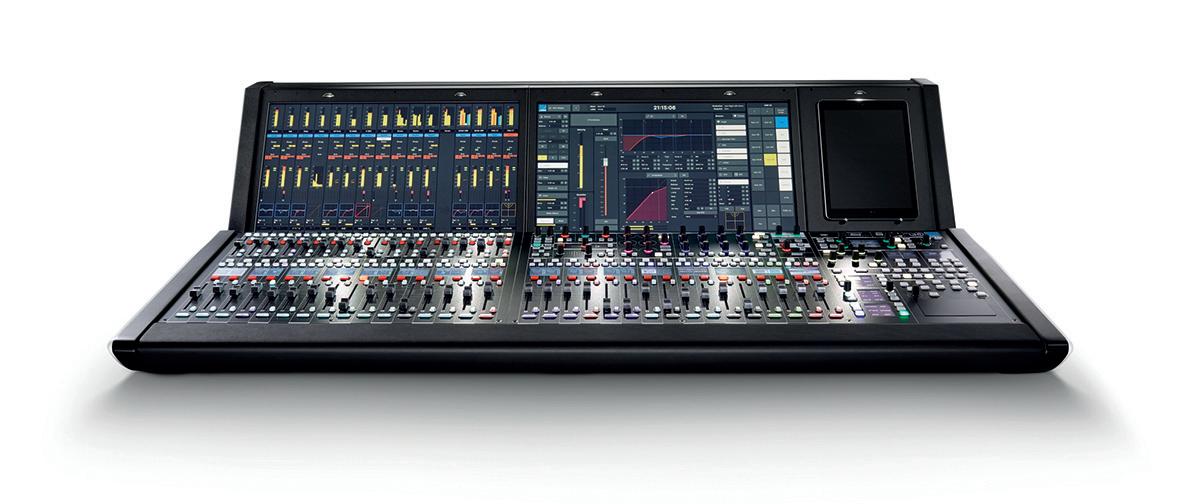

IP Conversion and Routing
Platform: An evolution in processing power, supporting 8K workflows and JPEG XS encoding/ decoding.
mc²/A__UHD Core/ Power Core Platform
Enhancements: For live productions with flexible bus routing, expanded AUX count, and support for radio broadcasting.
Booth Location: C4110
Limecraft will be highlighting media intelligence and real-time collaboration tools, calling for a reevaluation of the discussion around AI’s use in the industry.
LiveU will be showcasing its EcoSystem, underpinned by
the LiveU Reliable Transport (LRT™) technology, besides:
LiveU Cloud Connect: interconnects high-quality live video feeds from the field with various cloud production platforms, facilitating seamless integration into broadcast workflows.
Production Tools: including Video Return, Tally Light for on-air indication, Audio Connect for reliable audio solutions, and the LU610, a 1U rackmount contribution encoder designed for SNG trucks.
Offers: as solutions for advanced connectivity, such as Private 5G, Low Earth Orbit Satellite, and IP-based distribution, catering to a wide range of deployment scenarios including cloud, on-premises, SaaS, lease, and innovative pay-as-yougo options.
Customer-Centric Innovations: the latest advancements within the LiveU EcoSystem, emphasizing customerdriven innovation.
Hands-On Experiences and Sessions: discussing contemporary use cases and workflows in areas such as story-centric workflows, lightweight and cloud-remote production, content aggregation, and AI-augmented production.
Booth Location: SL5105
Marshall will be introducing the VMV-402-3GSH Switcher, a four-input autoscaling seamless switch designed for versatile applications in broadcast and production.
Booth Location: C5912
Matrox will be highlighting:
Capture Suite: Expanding support for the XMP file format and offering a complete playout and channel branding system.
Channel-in-a-Box: A turnkey broadcast television playout server suite designed for HD or UHD operation.
Cloud2TV: Virtual channel playout that’s softwarecentric, representing the future of video production and content delivery.
Booth Location: SL5073
Magewell will be exhibiting:
Modator Family: new line of high-density, modular, rackmount IP conversion solutions, including encoders and decoders, designed for scalability and reliability in professional production and AV workflows.
Modator 2U Chassis: A robust frame that accommodates up to 10 hot-swappable modules, featuring dual power supplies and optimized heat dissipation for 24/7 operation.
Modator Modules: Each

module offers independent network connectivity and baseband video/ audio signal to IP stream conversion, with a webbased management interface for ease of use.
Initial modules support NDI® video connectivity technology and include:
• Pro Convert HDMI Plus Module
• Pro Convert HDMI 4K Plus Module
• Pro Convert for NDI to HDMI Module
• Pro Convert for NDI to AIO Module
Booth Location: C6816
Mediakind will be showcasing its MK.IO Platform.
Live Demonstrations: Featuring targeted advertising for low latency sports streaming, showcasing the ecosystem’s ability to enhance fan experience and advertiser engagement.
Booth Location: W2401
Merging Technologies will be exhibiting its innovative range of audio technology and AoIP solutions, including the Anubis and Hapi hardware, the Ovation media server, and the Pyramix software.
Booth Location: 4732
MRMC will be showcasing its robotic camera technologies and virtual
production workflows, featuring Bolt X and Cinebot Mini for advanced camera robotics in virtual production.
Booth Locations: Central Hall Lobby L2 for the MRMC Unreal Ride 2024 and Broadcast Booth C4925.
Net Insight will be introducing Nimbra Connect iT, a solution
simplifying live internet transport for expanding networks. This platform
offers easy deployment, scalability, and streamlined operations.

Booth Location: W2421
Neumann will be highlighting its MT 48
Audio Interface: with both Music Mission and the new Monitor Mission, turning the device into a freely configurable monitor controller and audio interface for stereo, surround, and immersive formats. Additionally, Neumann’s broadcast microphones and studio classics will be on display.
Booth Location: 4732
OpenDrives will be unveiling the new Atlas platform and business model for media industry infrastructure, emphasizing efficient, agile, and high-performance data management.
Booth Location: SL8125
Panasonic Connect will be demonstrating their latest technologies designed to
streamline workflows from content capture to live event creation, featuring their advanced cameras and developments. Key highlights will include newly launched products and updates on Kairos, their IT/ IP platform.
Besides, the company will hold a press conference to unveil their partnership initiatives for the upcoming Paris 2024 Olympic and Paralympic Games. As a major sponsor, Panasonic will showcase their advanced AV technologies and products, emphasizing their commitment to “Sharing the Passion.” This presentation, scheduled for April 14th, aligns with the countdown to the Paris 2024 Games.
Booth Location: C3310
PlayBox Neo will be showcasing the latest enhancements to their broadcast playout and channel branding solutions, including AirBox Neo-20 and Capture Suite updates, and SMPTE ST 2110 support.
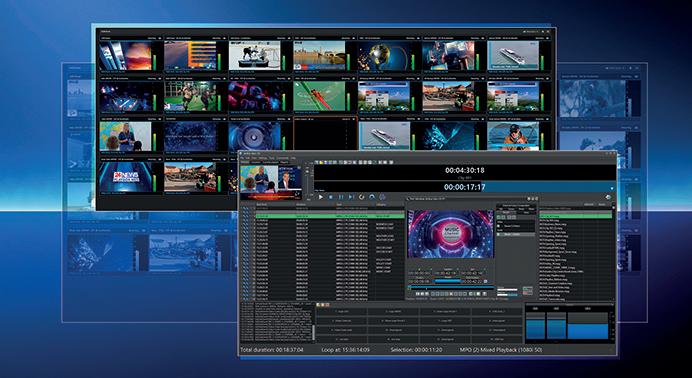
Booth Location: SL6099
Pliant Technologies will be showcasing:
CRP-C12 Compact Radio
Pack: compact radio pack designed for use with CrewCom or CrewCom CB2 systems, marking one of the industry’s smallest yet fullyfeatured professional radio packs.
Booth Location: C5310
Phabrix will be exhibiting its latest innovations in testing and measurement solutions, featuring
advancements in their Qx, Rx, and Sx Series. With a focus on supporting broadcast and media applications from production to postproduction and quality control, the company showcase will include updates to the Qx Series rasterizers and waveforms monitors, enhanced support for SMPTE Full Range video standards, advanced UHD/4K HFR formats in ST 2110 workflows, and legacy SD analysis.
Visitors can also expect to see the updated Rx Series with improved range monitoring tools and the portable Sx Series including the versatile Sx TAG hybrid device.
Booth Location: C5521
Pixotope will be introducing its cutting-edge virtual production tools, enabling broadcasters to create immersive content. The showcase will include extended reality, augmented reality, mixed reality, and camera tracking solutions, highlighting the transformative potential of these technologies in broadcasting and advertising.
Booth Location: North Hall meeting room
N201LMR
Pixitmedia by Kalray will be showcasing their ngenea platform, highlighting advancements in data management and storage for the media industry.
Booth Location: U4100
Proton Camera Innovations will be debuting as well as unveiling the Proton Cam, touted as the world’s smallest broadcast-quality
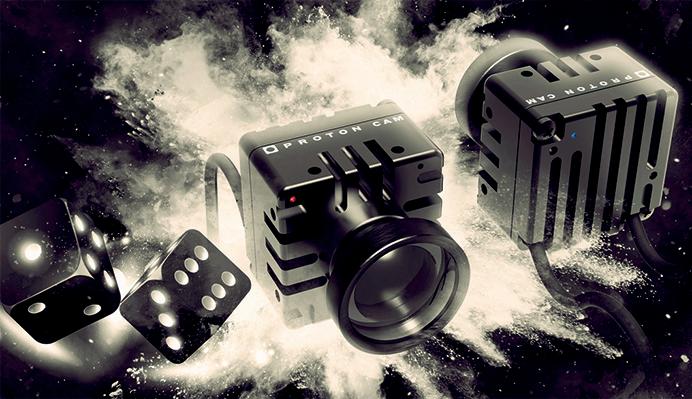
camera, featuring advanced imaging technology and a compact design for versatile use in sports, broadcast, and live events.
Booth Location: C3452
Qvest will unveil its digital transformation expertise in broadcast, media, and entertainment with a focus on the power of GenerativeAI (GenAI). The company will introduce practical GenAI applications, including optimizing CRM, automating ad sales, content licensing, and marketing asset creation.
Additionally, the company will present its integration
platform, qibb, designed for automating scalable workflows across the media supply chain.
Booth Location: W2821
Riedel Communication will be showcasing their MediorNet solutions, enhancing signal distribution and offering SDI-to-ST2110 conversion for various applications, including sports-betting services. They’ll also highlight their commitment to the Americas with expanded teams and facilities.
Booth Location: W2421
ROE Visual will be introducing for the first time a new product tailored for virtual production and the dynamic showcasing of the Ruby 1.9 wall. Attendees can experience hands-on demonstrations of the latest innovations, including the Obsidian solution, designed for on-set film applications. The company will also feature educational sessions focused on their new RGBW panel and incamera performance.
Besides, partners like The Studio-B&H and RED Digital Camera will feature ROE Visual’s technologies, with additional engagements announced on social media as the event approaches. The extended Ruby series, Graphite, and the Topaz series will also be exhibited, promising an important
event for industry professionals.
Booth Location: C4535
RTS Intercom Systems will be showcasing enhancements in intercom orchestration with new software that builds upon the AZedit software, offering clearer and faster system configuration. The company will also demonstrate the OMS (OMNEO Main Station), a key component of their digital partyline family that serves as a bridge from analog to IP, connecting various communication formats.
Additionally, RTS will feature their scalable ODIN system in a broadcast
mobile truck for managing communications during significant live events.
Booth Location: C3810 Sapec
Sapec will be showcasing future-ready UHD solutions compatible with the SMPTE 2110 IP standard. The company will demonstrate the latest evolutions of their Laguna, SIVAC-ONE, and Gredos II equipment. With a focus on adapting to new IP and hybrid workflows, they’ll also present the integration of RIST for public network content transport and the SMPTE 2110 interface for European decoders, proving their agility in meeting the broadcast sector’s evolving needs. Additionally, collaborations with The CornerCam, VideoMOS, and Acromove will

be featured, emphasizing SAPEC’s commitment to technological evolution in the broadcasting world.
Booth Location: W3930
Sencore and Showfer will be showcasing how their collaboration aims to redefine content transport, monitoring, playout, and workflow scheduling with Showfer’s “ProVision” platform and Sencore’s Centra Gateway for content transport and monitoring.
Booth Location: W2401
Sennheiser will be highlighting MKH 8030 RF condenser microphone and accessories for MKH 8000 Series, as well as presenting its streamlined and improved headset portfolio for broadcast applications.
In addition to the booth presentations, exclusive information sessions on Wireless Multichannel Audio Systems (WMAS) will be offered in demo room N204LMR.
Booth Location: 4732
SMPTE (Society of Motion Picture and Television Engineers) will be presenting educational sessions covering a range of topics from emerging technologies to virtual production: discussions on projection technologies, capturing musical events, IMAX, MSG Sphere technology, virtual production, enhanced membership benefits, IMF efficiency, camera metadata for VFX, AI’s impact on
fi
lm and TV, generative AI, problem-solving in virtual production workflows, and control plane and live streaming challenges.
Booth Location: W210-W212
Sony will be demonstrating its powerful range of solutions to empower content creators; but the main course will come when the company will introduce the Advanced Watermark Security package through its Ci Media Cloud to enhance content protection.


This feature, available with enterprise subscription plans, includes Watermarked Workspaces for standardized visual watermarking on media files, and Forensic Watermarking developed with NAGRA’s NexGuard, enabling traceable sharing with unique watermark IDs.
Additionally, Ci offers burnin watermarking, integrated into the MediaBox sharing tool.
Booth Location: C8201
Stage Precision will be showcasing its virtual production toolkit. Known for its software solutions in augmented reality, virtual production, and live events, the company has been part
of major productions like the 2024 Super Bowl. Their SP and Shield software allow integration with multiple tracking systems and enhance workflow management. Key features include lens calibration, augmented reality pipeline with Unreal Engine integration, and the custom API, SPnet, for seamless data streams.
Booth Location: C4535
StreamGuys will be unveiling an updated version of its RevenueStream service. The service now includes enhanced subscription management, branding, payment features, and versatile monetization options. Designed to
cater to a diverse user base, from worship events to sports leagues, the platform integrates with SGplayer for a seamless user experience and offers expanded payment options for secure transactions.
RevenueStream’s integration with Pigeon.io subscriber management and SGcontrol tokenization service underscores its commitment to content security and revenue growth.
Booth Location: W1743
Synamedia is launching MEG.mini, a solution for B2B video distribution, enhancing their SaaS portfolio. It’s designed for delivering a small number of channels, offers a lowcost, software-based alternative to traditional receivers, potentially reducing costs by up to 80%, as the company states. It’s optimized for satellite, IP, and CDN distribution, with quick, secure setup on off-theshelf platforms.
Booth Location: W2801
TAG will be showcasing advanced data capabilities, quality of experience measurements, intelligent language detection, and HDR workflows, along with new technologies and partner integrations for media workflows optimization.
Booth Location: W1655
Tedial will be exhibiting smartWork, the first cloudnative, no-code integration platform tailored for the media and entertainment sector. This platform is designed to enhance user collaboration and experience through customizable UIs, facilitating seamless workflow automation and partner collaboration. Key features include a BPM workflow designer, form designer, metadata editor, and UI designer, emphasizing the platform’s no-code, usercentric design.
Booth Location: W1751

Telemetrics will be showcasing significant updates across their camera control systems. Highlights include enhancements to the RCCP-2A Robotic Camera Control Panel, making the OmniGlide® Robotic Roving Platform smarter, and improving the TG4/5 camera trolley and track systems for smoother, more precise, and safer operation. Key features like Studio View, Power View, and Virtual Tracks will be demonstrated, alongside new software
improvements to the reFrame Talent tracking software and the introduction of the TG-5 Robotic Camera Trolley.
Booth Location: C4420
Telos Alliance will be highlighting their collaboration with AWS, featuring a virtual intercom system as part of the AWS Live Cloud Production demo. This setup will facilitate seamless communication for teams located across different sites, demonstrating the
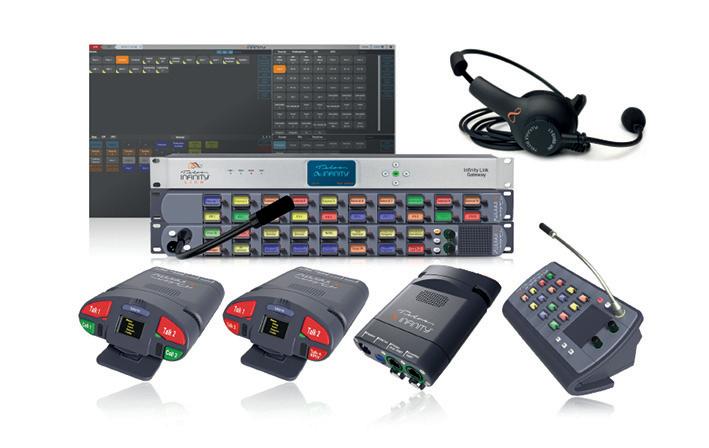
potential of cloud-based broadcast tools.
Booth Location: C1808
Telestream will be introducing…
• Cloud-based solutions:
GLIM as a service: enabling instant playback of highresolution content through a web browser, streamlining remote production by reducing the need for downloads or specialized hardware.
Live capture as a service: designed to simplify the capture of live content from any location, allowing
for real-time production and overcoming traditional remote setup challenges.
• Qualify QC Updates:
IMF Compliance with Netflix Photon Support: Ensuring Interoperable Master Format (IMF) packages adhere to industry standards.
Harding FPA Test:
Incorporating detection capabilities for content that could potentially trigger epileptic seizures.
DolbyE Presence and Dolby Vision Validation: Confirming the inclusion and accuracy of DolbyE audio and Dolby Vision metadata.
Rude Word Detection: Screening content for inappropriate language to maintain suitability for all audiences.
• AI-Powered Media Processing Tools:
- Automated Workflow Creation
- Intelligent Quality Control (QC)
- Efficient Captioning and Subtitling
- Simplified Technology Adoption
Inspect Monitoring Platform: for monitoring media stream integrity across ST 2110, SRT, and NDI protocols.
DIVA 9: a hybrid content management solution that facilitates the transition of media assets between on-premises and cloud environments.
Booth Location: W1501
Teradek will be unveiling the Prism Flex Mk II, enhancing its Prism Series with features like improved
front panel controls and cooling mechanisms. This new version integrates analog audio IFB for better communication and remains compatible with all Prism devices, focusing on internal and software upgrades. It supports a range of protocols and offers features such as low latency streaming, concurrent encode/decode capabilities, and direct uploads to camera-to-cloud platforms. The Prism Flex Mk II is designed for live video contribution, remote production, and postproduction workflows.
Booth Location: C5916 & C5816
V-Nova will be introducing its MPEG-5 LCEVC technology, enhancing video compression for higher quality at lower bitrates. They’ll also share, through conferences, insights from Brazil’s TV 3.0 and Paris Olympics live broadcast trials, demonstrating the advancements in digital terrestrial broadcasting.
Additionally, V-Nova Studios will introduce the PresenZ
6DoF video format, offering cinematic photorealism with six degrees of freedom for an immersive VR storytelling experience.
Booth Location: W3454 & W3455
Vislink will be introducing innovative solutions for live event coverage, including Hybrid IP/COFDM applications, private 5G for productions, cloudbased remote production, AI-driven live sports and in-studio systems, OB truck solutions, and ENG airborne downlinks. Highlights include the LiveLink bonded
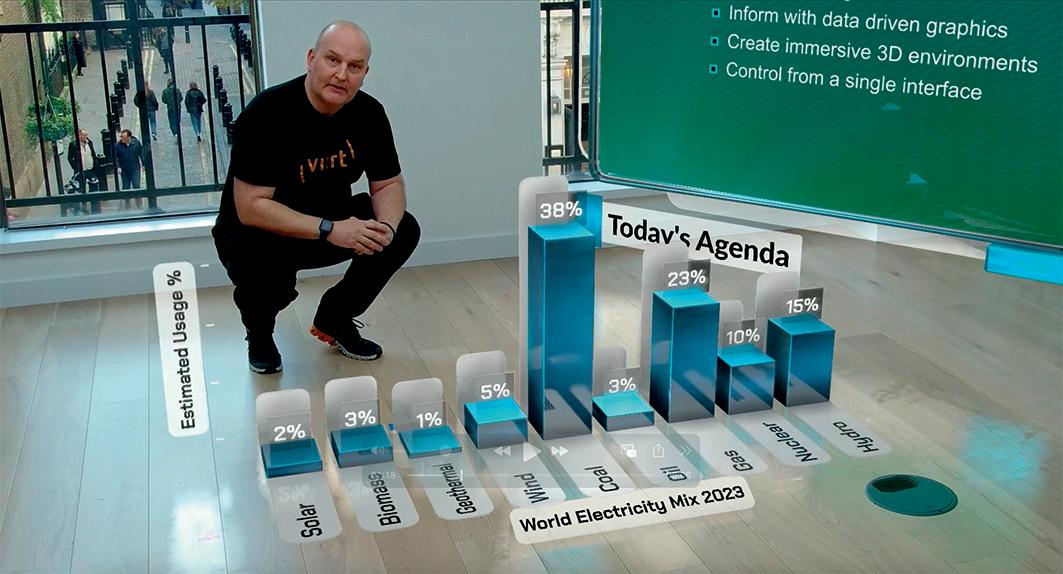
cellular transmitter, the Cliq wireless camera transmitter, the vPilot automated studio system, the LinkMatrix all-IP workflow system, and the TerraLink 4CM REMI encoder for multicamera HD broadcasts.
Booth Location: W3632
Vizrt will be exhibiting:
• Vizrt Live Production solutions, including endto-end live production in the cloud via Viz Now, the graphics platform
Viz Engine 5.2, and its integration with Unreal Engine for real-time graphics and branding. Solutions for HTML5 graphics and social engagement will also be featured, demonstrating how they integrate with TriCaster range to elevate broadcasting and streaming with online overlays and live data integration.
• TriCaster 2 Elite and Flex Dual Control Panel: These systems will be highlighted for their powerful switching, compositing, and IP
connectivity capabilities. The TriCaster range is known for its versatility and integration with NDI.
• Viz Virtual Studio Go and Viz Libero Go: for adding Augmented Reality (AR) graphics and virtual sets to TriCaster production, designed for connected workflows of NDI, and to offer out-of-the-box hardware and software
sports analysis solutions with innovative data visualizations.
Booth Location: SL5061
VoiceInteraction will be showcasing its speech processing solutions and also presenting Audimus. Media for real-time automatic closed captioning and MMS, for media generation and content repurposing automation, leveraging ASR and AI algorithms.
Booth Location: W3167

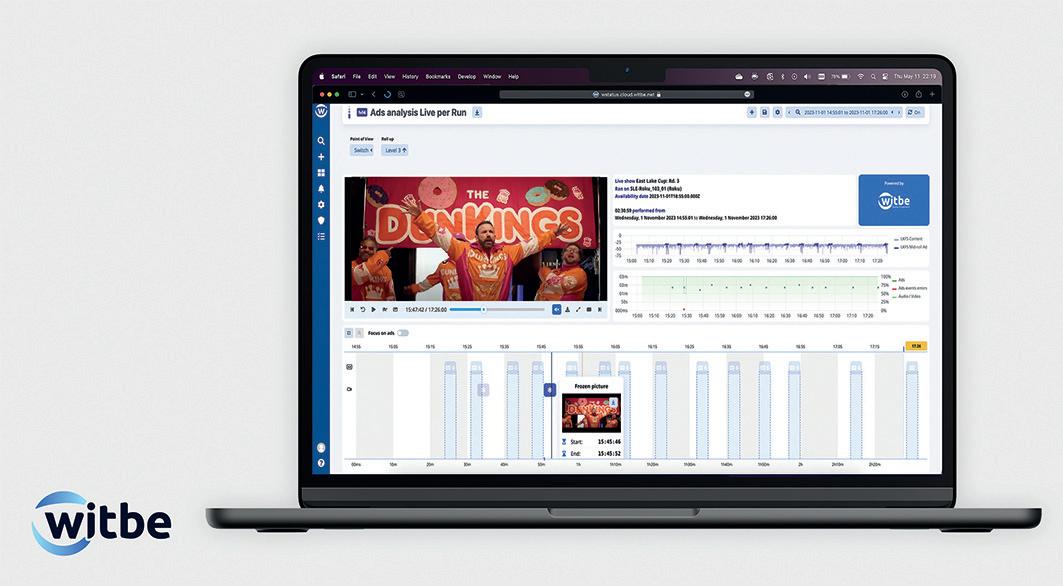
Vubiquity, an Amdocs company, will be highlighting their Media Supply Chain solutions, focusing on AI/ML technology for VOD and FAST content, localization, metadata management, and more. The Amdocs’ company will as well introduce the MetaVU title management SaaS solution, offering centralized, AIenhanced metadata management.
Booth Location: W3567
Witbe will be introducing its testing and monitoring
suite for video streaming, including new Ad Monitoring technology for dynamic ad insertion analysis. The company will demonstrate their solutions for streaming services, including automated QA testing bundles, major software suite updates, and the complete Witbox device lineup.
Booth Location: SU4100
WorldCast Systems will be unveiling the APT IP Silver MPX Encoder and Decoder, enhancing the transmission
of FM-MPX signals with cost efficiency and high quality. These devices stand out for their ability to deliver analog composite/MPX signals using the APTmpX compressed format, which offers signal transparency, minimal delay, and IP transmission stability while conservatively using bandwidth.
Features will include advanced networking, VLAN tagging, NAT traversal, SureStream Technology for IP redundancy, NTP-based Time Alignment for precise stream adjustments, and ScriptEasy software for remote device control and monitoring.
Booth Location: W3449
Wisycom will be introducing its latest wireless technology and distributed antenna systems. Key innovations include the MRK16 multichannel receiver system, the compact MTP61 bodypack transmitter, and the versatile MCR54 true diversity receiver.
Additionally, Wisycom’s RF-over-fiber capabilities will be demonstrated with the BFL interfaces and the optional EX3 card, illustrating long-range, high-quality transmission solutions.
Booth Location: C7507
Zero Density will be showcasing their latest virtual production and real-time motion graphics solutions, including their new Unreal Motion Designpowered approach. The company will present live demos, focusing on election coverage and transforming sports broadcasts with immersive graphics. Key highlights include their Reality5 virtual production platform, Lino real-time motion graphics platform, and the new render hardware platform Ampere EVO2.
Additionally, they will feature their Traxis tracking platforms and host exclusive talks and a happy hour in collaboration with industry partners.
Booth Location: SL2038
Zixi will be showcasing their Software-Defined Video Platform (SDVP). Zixi will demonstrate new product updates, performance capabilities, and connectivity with the industry’s largest ecosystem. Highlights include their latest software suite advancements, such as High-Performance Networking and Dynamic Latency features, and new product releases like Broadcaster v17.
The company will be also involved in discussions about industry experiences with SDVP at the Devoncroft Executive Summit and presentations about managing ultra-low latency in live IP video workflows.
Booth Location: W1401

EBU starts a new era in free-to-air sports broadcasting

Last month we learnt about a new development within the world of sports broadcasting: the creation of the Eurovision Sport streaming platform, which marks a significant evolution in the field. Spearheaded by the European Broadcasting Union and in close collaboration with technology partners like Nagravision, this initiative aims to redefine how sports content is delivered and experienced across the globe. As our readers dig in the interview with Jean-Baptiste Casta, Head of Strategy & Business Operations at Eurovision Sport, they’ll gain insights into the intricate process of bringing this ambitious project to life, from the technical hurdles to strategic decisions that shaped the platform’s development.
Within this interview to Jean-Baptiste Casta, TM Broadcast International offers a behind-the-scenes look at the challenges faced and the innovative solutions employed to overcome them, highlighting the platform’s commitment to providing high-quality, free-to-air sports content. From managing complex geo-blocking rules to integrating diverse content schedules and ensuring a smooth user experience, the interview sheds light on the collaborative effort to make Eurovision Sport a reality.
With this conversation, readers will discover the platform’s mission to complement traditional broadcasting, its approach to content management, and the vision for its future in the sports broadcasting stage.

Who has been the main technology partners involved in the development of the Eurovision Sport streaming platform and what roles have they played in its creation?
I’m thrilled to discuss our collaboration with Nagravision, a Kudelski Group company, in the development of the Eurovision Sport streaming platform. This partnership represents a significant step forward in our mission to bring high-quality, freeto-air sports content to fans worldwide.
Nagravision has been an instrumental technology partner in this venture.
Their expertise in content protection, media, and entertainment solutions has been invaluable.
As one of the world’s leading independent providers in these areas, Nagravision’s role has been multifaceted, focusing on the technical operations of the Eurovision Sport platform. This includes managing content, user experience, and ensuring a secure, immersive, and easily navigable digital environment for fans to enjoy their favorite sporting events.
Our collaboration has enabled us to aggregate sports rights effectively and complement the offerings of Europe’s Public Service Broadcasters. The platform’s design allows for minute-by-minute rights management and provides a comprehensive sports guide, managing thousands of hours of content across various sports categories and dedicated portals for Federations and sporting organizations.
Innovation is at the heart of Eurovision Sport, and Nagravision’s contribution has been pivotal in ensuring

we can offer customizable viewing experiences to fans. The upcoming integration of the Eurovox service, an AI-based live translation of sport commentaries, is a testament to our commitment to innovation and inclusivity, enabling fans across Europe to follow their favorite events in their preferred language.
Together with Nagravision, we are dedicated to enhancing the future of broadcast media, ensuring that highquality sports content is accessible to all, free of charge. This partnership
is a cornerstone of our strategy, and we look forward to continuing our collaboration to bring unparalleled sports viewing experiences to fans around the globe.
What kind of storage solutions and web architecture has been implemented to ensure a smooth and efficient user experience on Eurovision Sport?
Innovation is at the heart of Eurovision Sport, and Nagravision’s contribution has been pivotal in ensuring we can offer customizable viewing experiences to fans.
What MAM technologies and solutions have been used to manage the vast sports content available on the Eurovision Sport platform?
I’d highlight our platform’s use of advanced MAM (Media Asset Management) technologies integral to managing our extensive sports content library. Utilizing solutions like those described for the OpenTV Video Platform by NAGRA, we ensure efficient content curation, personalization, and seamless delivery across multiple devices. This includes a comprehensive metadata management system for dynamic content cataloging and an analytics-driven approach for understanding
consumer behavior, crucial for adapting our offerings in real-time to meet viewer demands.
The platform is 100% cloud based, using many leading global cloud technology partners such as AWS. The snappiness of the user experience is facilitated by very extensive caching on the client app.
What were the development timelines for the Eurovision Sport platform from conception to launch?
The EBU has been exploring the opportunity to launch a direct-to-consumer sport platform during the past couple of years. A certain number of pilot projects, to evaluate the various technologies as well as the market opportunity were run during that period.
What technical and non-technical obstacles were encountered during the development of Eurovision Sport and how were they solved?
During the development of Eurovision Sport, we faced several challenges, both technical and strategic. Technically, managing complex geo-blocking rules and integrating diverse schedules from numerous federations required bespoke tools, which we developed specifically for these tasks. We also addressed the challenge of content delivery by implementing measures with CDN providers to ensure even less popular content remains accessible. On the non-technical side, our focus was on sustainable monetization through advertising and sponsorships, carefully balancing programmatic ads with direct sales campaigns. Importantly, we clarified Eurovision Sport’s role as a complementary platform to EBU Members, enhancing rather than competing with their coverage, and providing unique content not available on traditional freeto-air channels.
What were the main objectives that led to the development of
Eurovision Sport and how do they align with the EBU’s mission?
The main objectives are to provide additional live (or replays) coverage to sport events, 1) in complementary to EBU Members coverage and 2) full coverage to sport events that have no or limited broadcast support from media. We are a Public Service therefore we aim to provide the fans free access to the content, no pay per view or subscription to pay.
How does the EBU plan to measure the success and impact of Eurovision Sport in terms of reach, user engagement and satisfaction?
Everything we do is done in close collaboration with EBU Members and the Sport federations we are partnering for media rights. Their feedback and satisfaction are key too. We will constantly listen to all stakeholders to adapt and improve the way we bring sport to fans. Fans feedback will also be the other indicator for us.
If the sport community support these initiatives, if
we manage to provide the sport fans the content they want to see, we will have achieved our Public Service Media mission which is to democratise access to sport.
What cybersecurity measures are in place to protect the Eurovision Sport platform and its users’ data against online threats and security breaches?
Regarding to this issue, as we made sure of it at first, we can assure that Nagra followed all GDPR regulations and recommendations to protect user’s data.
How does Eurovision Sport manage user authentication and authorization to ensure secure access to content?
The process is easy: every user has to be registered and email address verified to have access to the content playback. The content itself is encrypted and DRMised using the Nagra MultiDRM solution. For each content access, a

DRM-license is generated for the user.
What file compression protocols does Eurovision Sport use to optimize live and ondemand video streaming while maintaining high image quality?
We use fully standard cloud video encoding provided by AWS elemental. Packaging and delivery are relying on the use of Apple HLS + MPEG-DASH packaging for OTT delivery.
How does Eurovision Sport balance the need for efficient compression
with user demand for broadcast quality and sports federation standards?
With adaptive streaming we deliver multiple qualities to fit the Users’ bandwidth.
With good network connectivity, the user can benefit form 720p and even 1080p HD quality.
What systems and practices does Eurovision Sport use for audio file management, especially with regard to video synchronization and sound quality?
We ingest the source feeds using SRT transport
streams including Video and Audio. The re-encoding process keeps the sync between audio and video avoiding desynchronisation issues
How does Eurovision Sport ensure consistency and high quality audio across all viewing platforms, including mobile devices, web and connected TVs?
HLS and DASH are adaptive streaming protocols providing different stream qualities. All devices having a good internet bandwidth will benefit form the same highest Full HD quality.

The beginning of the year saw a milestone in the Spanish audiovisual sector: the transition of all terrestrial broadcasting to HD. The wrongly so-called ‘analogue blackout’ -nor that SD DTT was analogue, anyway- has also driven public broadcaster RTVE to finally begin permanent broadcasting in UHD. And if from SD to HD we have no doubts, -as resolution was multiplied by four- the move to UHD can be a little more awkward.

It wasn’t that simple from SD to HD
In the evolution from SD to UHD, the first milestone -HD- was quite ‘simple’. Although concepts such as ‘HD ready’ appeared in an attempt to establish an intermediate resolution, which amounted to little more than a commercial strategy from TV manufacturers that led to some confusion, it
By Yeray Alfageme, Senior Manager, Business Consulting at Optiva Media an EPAM companyactually entailed a leap in resolution.
Taking into account the two existing standards for analog signals -some of whose parameters have been inherited by digital signals-, under the NTSC standard SD resolution was 720 x 480, while the PAL standard had a resolution of 720 x 576. Originally, aspect ratio was 4:3 but, thanks to the anamorphic artifact, it was possible to have an aspect ratio of 16:9, which would be the only one to this day. As you can see, it seemed ‘only’ a change in resolution, but it
involved some complexity.
In an environment of coexistence of analog and digital signals under these parameters, and although in countries such as Japan NHK did some analog HD experiments -as it was also the case here in Spain with Retevisión in the 1992 Olympics- the leap to digital HD signals was finally taken. We left behind any aspect ratio other than 16:9 -which was a joy- and a single resolution of 1920 x 1080 was introduced. So far everything perfect. TV manufacturers struggled to meet the demand and
pulled out their sleeves -that’s how it came aboutthe ‘HD Ready’ resolution. This sort of commercial invention established an intermediate resolution of 1280 x 720 by which chiefly small format television sets were capable of receiving HD signals without the need for more expensive panels. Thanks to everyone, this was short-lived and quickly fell into oblivion without affecting the production environments.
HD brought us another concept that until then had no greater complexity: scanning. In SD all the
signals were interlaced, since that was the way that cathode ray tube TVs displayed the images, a method that was a legacy until the emergence digital signals; but HD meant an opportunity to evolve. Progressive scanning was introduced, the PAL standard saw signals featuring 25 frames per second interlaced in 50 fields increase to 25 progressive or complete frames. The amount of information transmitted was the same, but in a different way.
And then came UHD.
And the thing is that ultra high definition is much more than a leap in resolution. With analog times well behind us and TV sets capable of displaying much higher resolution, colorimetry, images per second and a greater range of brightness, it is time to leave behind past legacies and take a real leap.
The first parameter that evolved, just like when going from SD to HD, is

The leap from SD to HD is much more straightforward, although not without some complexity, as compared to the transition from HD to UHD
resolution. This is the easiest one. We again multiply the number of pixels in our image by four and move to a resolution of 3840 x 2160, but finally now featuring progressive scanning and, just like in HD, always with a 16:9 aspect ratio. But with a little rub. There is another kind resolution, called DCI 4K, which sets forth a resolution of 4096 x 2160 and an aspect ratio slightly higher than 17:9 and oriented to cinema but, as far as we are concerned, UHD resolution can be considered a single one.
Let’s move on to the second parameter of UHD: color. Both in SD and HD -although in HD we can also have signals with extended color space- the BT.709 color space was defined,
again a legacy due to the colorimetric reproduction capacity of the phosphors fitted in analog cathode ray tube screens. A new BT.2020 color space is defined in UHD. It is a color space that maintains the white point D65, 6500K, as in BT.709, but extends its primary colors, thus making them purer, to cover more than 90% of the color range visible to the human eye. This new color environment is defined as WCG, or Wide Color Gamut.
The next parameter, and perhaps the best known for the improvement it entails for the image, is HDR, High Dynamic Range. In this case it consists of an increase -a very considerable oneof the contrast range that an image is capable of displaying. There are different standards and this range can be adapted to the image to be represented through static and dynamic metadata systems that set points of black and white, minimum and maximum luminosity, in a changing way. And it turns out that SDR, Standard Dynamic Range, was one
of the biggest differences between the signals on our screens and the perception of the human eye, and with HDR they become narrower. much more so.
These parameters -WCG and HDR- will lead us to increase the number of bits that each pixel must contain in order to represent a greater dynamic range and color range, as well as to facilitate a better representation of textures on surfaces, making them more realistic. The 8 bits that were used until now are not enough any longer and standards appear in 10 and even in 12 bits per pixel. In fact, HDR implies that the signal is WCG, so this backward compatibility that we will review later is not such or, at least, not so straightforward.
The fourth parameter that characterizes UHD is New Generation Audio, or NGA. Compared to stereo or multichannel audio -5.1 for example-, NGA defines a new method for capturing and propagating sound by using objects instead of channels. This
will allow us to offer new experiences that are much more immersive, adapt playout systems, and expand the offering of sound customization and accessibility. Again, there are several standards on the market, such as Dolby Atmos or MPEG-H, but all of them are aimed at providing these new functionalities that were not possible through sound before.
And the fifth parameter in UHD image resolution is HFR, or High Frame Rate. In this case, the concept is simple: at least twice the number of frames per second that are displayed, going from 25 or 30 images per second to 50 and 60 respectively, or even higher. It has been shown that, at very high resolutions, such as 4K, and, above all, with high dynamic range and the normal screen viewing distances in a typical living room, the different frames gradually become perceptible, especially for images with a lot of motion such as motor sports or certain fiction scenes, if the current standard of 25 or
30 frames per second is used. The direct implication of this is to double the amount of information needed and this is the case, although there are compression and coding techniques that allow to increase efficiency and not to quite double said information flow.
As we can see, the leap from SD to HD is much more straightforward, although not without some complexity, as compared to the transition from HD to UHD. In fact, posing the question that gives the
title to this article, “What is actually UHD?” starts to become appropriate. Let’s get to the controversy, but first let’s see what the industry standards say.
The two standards applicable to UHD signals are BT.2020 and BT.2100.
The BT.2020 standard, also known as Rec. ITU-R BT.2020, sets the parameters for transmission of ultra-high

resolution (UHD) video signals. This standard defines a wide range of features that a UHD signal must meet to ensure optimal image quality.
Key parameters include a minimum resolution of 3840 x 2160 pixels -four times the resolution of Full HD- as well as a color depth of at least 10 bits per channel, thus allowing for more accurate and detailed color reproduction.
In addition, as we discussed earlier, BT.2020 specifies a broader primary color
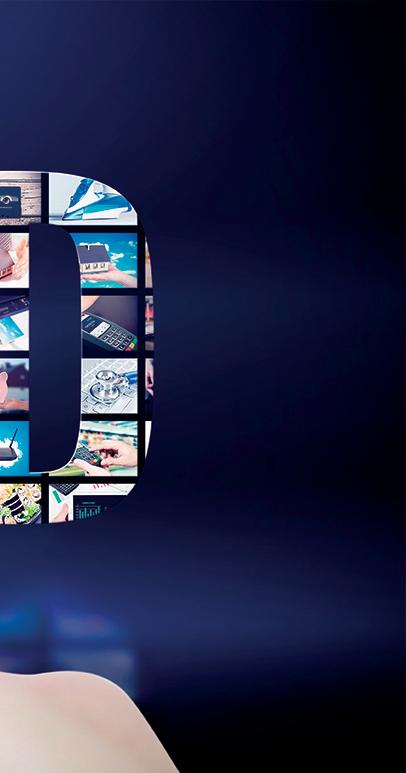
The BT.2100 standard, or Rec. 2100, represents a significant progress in video signal transmission technology, focusing specifically on improving the viewing experience of High Dynamic Range (HDR) and Wide Color Gamut (WCG).
space, known as BT.2020, which encompasses a wider spectrum of colors than previous standards, such as BT.709, this resulting in a richer and more vibrant color gamut.
The BT.2100 standard, or Rec. 2100, represents a significant progress in video signal transmission technology, focusing specifically on improving the viewing experience of High Dynamic Range (HDR) and Wide Color Gamut (WCG). This standard introduces the concepts of PQ (Perceptual Quantizer) and HLG (Hybrid Log-Gamma) as two major methods for HDR representation, each of them designed to meet different viewing needs and conditions.
PQ offers a gamma curve perceptually more adapted to the human eyesight, thus resulting in a more realistic
reproduction of brightness and contrast, while HLG is a more compatible option that allows reproduction on SDR (Standard Dynamic Range) devices without losing detail in areas of high brightness or shadowing, only from the point of view of luminance since, as we have mentioned, HDR currently requires a signal to be WCG. In addition, BT.2100 provides tools to prevent the loss of luminosity in highly saturated colors and in areas of the image with high spatial frequencies (highly contrasted edges). This standard also defines the technical parameters for transmission of ultrahigh resolution (UHD) video signals, including a minimum resolution of 3840 x 2160 pixels and a color depth of at least 10 bits per channel, just like BT.2020.
Can we consider a 2160p50 SDR signal featuring BT.709 color space and stereo audio as UHD? Well, there are those who say yes, and there are those who say no. If we are objective and consider that the five parameters described here must be met, a signal like the one described above only meets one of the five -resolution- but it is not WCG, it is not HFR, nor HDR or NGA, so it cannot be considered UHD. On the other hand, a signal with 3840 x 2160 resolution does not fit in any previous standard that defines HD signals, which could be considered UHD, especially when it comes down to selling TV sets.
Let’s not merely scratch the surface and ask the experts in the field to try to shed some light on this.
And there is nothing better than to ask those who
know. To do this, we have relied on two colleagues who have been studying and working on these new formats for a long time and have not only ideas, but conclusions about them. Jose Manuel Menéndez, professor and director of the RTVE Chair at Polytechnic University of Madrid, and Emili Planas, CTO of Grup Mediapro.
«Given the number of times the question ‘What is UHD?’ has come up at the meetings we have had between friends and colleagues in the industry, it is starting to become the million-dollar question. It is usually associated with the question that relates to UHD signal and size for home screens, but this second question is better addressed in another article, in depth and at length.
Defining what a UHD signal is turns out to be very easy if we stick to the regulations and recommendations that have been published by entities that regulate the sector, such as ITU (International Telecommunication
Union) and EBU (European Broadcasting Union).
According to the BT.2020 recommendation, “UHD -ultra-high-definition television- will offer viewers a better viewing experience mainly due to a wide field of view, both horizontally and vertically, on screens of adequate size for use in homes and public places. The applications of UHD require system parameters that exceed those of HD.”
One thing is clear. UHD beats HD and it is made explicit that there is a difference between the two. In addition, the same recommendation defines the parameters that are considered for UHD: resolution of 3840 x 2160 pixels (referred to in the EBU TR 037 document as UHD-1 or 4K) and 7680 x 4320 pixels (UHD-2 or 8K according to the EBU glossary), plus WCG, HFR ranging from 24/1,001 to 120 frames/second, NGA and use of 10 or 12 bits (often referred to as HBD – High Bit Depth). So far, everything is clear about the differences between HD and UHD. Then came the BT.2100 recommendation,
which brings HDR to both UHD and HD signals, and everything got messed up.
But of course, migrating from HD to UHD is not a trivial matter, neither in production, nor in contribution links or regarding dissemination to users. For this reason, EBU suggested to carry out the migration in several stages:
• Migrate from HD to 1080i25 conventional interlaced, then to 1080p24-60 (progressive, with 24 to 50 or 60 frames/second refresh rate) with HBD, HDR, WCG and NGA, and this was called “1080p Advanced 1”.
• Then move on to “1080p Advanced 2”, which involved cranking HFR up to 100 or 120 frames/ second
• Then move on to “UHD-1 Phase 2”, which involved upgrading resolution to 3840 x 2160, using HBD, HDR, WCG, HFR up to 50 or 60 frames/second and NGA.
• And then finalize the transition with full “UHD-1 Phase 2”, including HFR
up to 100 or 120 frames per second.
UHD-2 is reserved for resolutions of 7680 x 4320, and it is assumed that it will still take some time for it to become widespread in homes, given the limitations of the broadcast systems.
It is all very clear. HDTV is 1080p (we get rid of interlacing, at last!), and UHDTV is 4K and 8K. But, it is true that both HDTV and UHDTV must evolve to use full phase 2 (HBD HDR WCG HFR NGA). Some call HDTV with full phase 2 ‘enhanced HD’, but EBU only sees it as one more step towards reaching full UHD-1 phase 2.
And, if you ask me, then I think I’ll second EBU’s proposal, if only to define clear targets for progress. There may be entities that make more progress and others less but, at any event, it is for sure that signal quality and QoE offered will be very good. What’s more, it’s always a good thing to have competition in offering the best signal...»
José Manuel Menéndez«I think it is good that, in the more technological environment, we analyze each of the parameters that make up the UHD concept from a practical point of view. In my opinion, of the five parameters you mentioned, HDR and WCG are essential, as they can be appreciated in any type of production and at any viewing distance. HFR is the most demanding extra feature in terms of bandwidth and we should be flexible when considering it indispensable for a particular number of frames per second. If dealing with cinema content, 25fps can be accepted exceptionally, but 50fps should be the minimum required to formally be considered UHD. Increasing to 100 or 120fps may be a recommended improvement, but this involves such a large financial effort in relation to the improvement, that it is unrealistic to consider it mandatory. Quite the same goes for NGA, which happens to be a muchneeded added value, but considering the reality
of user sound devices, I don’t think we can claim it as indispensable for attainment of the UHD label.
And I’ve left the issue of resolution for last, as this is where the controversy increases. Is a resolution 3840 x 2160 required for UHD? Well, clearly not! Add to this the fact that the capabilities and limitations of the human visual perception system (HPPS) are what they are. At a certain distance from the screen (whatever the screen), the number of pixels we are able to see is limited. There are some tables on which more or less everyone agrees that allow us to find out what the optimal resolution is based on screen size and the viewing distance. Let’s take a 65-inch screen as an example: in order to distinguish between a 2160p or 1080p resolution, we must be at less than 3 meters from it. At more than 3 meters, most humans will not be able to tell an image of 1080 x 1920 from the same image with higher resolution.
Therefore, if we have bandwidth and technicaleconomic feasibility to produce and broadcast in 2160p, let’s go ahead, we will be able to get very close to the TV. Otherwise, a 1080p resolution is sufficient.
From my point of view, the most versatile and realistic format for the coming years is 1080p50 HDRWCG. Broadcasting should always feature NGA audio and each production will use the most appropriate functionalities in each case.»
Emili PlanasIn our detailed analysis on Ultra High Definition (UHD), we have explored the various parameters that define this advanced image and sound format. From the move from Standard Definition (SD) to High Definition (HD) to the advent of UHD, we’ve seen how every technological leap involves not only higher resolution, but also significant improvements in color, dynamic range, frame rate, and audio experience.
UHD, with a main resolution of 3840 x 2160 pixels, goes beyond simply multiplying the number of pixels on the screen. It is a set of features designed to deliver a more immersive and realistic visual and listening experience. From WCG, which broadens the color spectrum, to HDR, which improves contrast and brightness, each component is designed to take image and sound quality to a higher level.
In this sense, the opinions of experts in the field give us a valuable perspective.
José Manuel Menéndez, professor and director of the RTVE Chair at the Polytechnic University of Madrid, and Emili Planas, CTO of Grup Mediapro, shared their views, which shed light on the definition and applicability of UHD in practice.
José Manuel Menéndez, with his vast experience in the field, emphasizes the importance of sticking to the regulations put in place by entities such as ITU and EBU. According to the BT.2020 recommendation, which defines the
parameters of UHD, it is clearly established that this format improves upon HD and the key requirements are detailed: resolution of 3840 x 2160 pixels, WCG, HFR from 24 to 120 frames/second, NGA and 10 or 12 bits per pixel.
Menendez explained how EBU has proposed a gradual migration from HD to UHD, splitting the process into stages such as ‘1080p Advanced’ and ‘Full UHD-1 Phase 2 Complete’. Their perspective points to a clear technological evolution towards full UHD.
On the other hand, Emili Planas provided a practical vision, highlighting the importance of HDR and WCG as essential elements for a meaningful UHD experience. In addition, he considers HFR and NGA to be valuable features, although not necessarily indispensable in all cases. As for resolution, he raised an interesting debate by questioning whether 3840 x 2160 pixels is always necessary to be considered UHD. He argued that a 1080p resolution with HDR-WCG at 50 frames per second could be a more
realistic and versatile option for many scenarios.
These insights from experts show us that the path to UHD involves not only adopting new technical standards, but also adapting content production and consumption to take full advantage of these advanced capabilities. As technology and infrastructure continue to develop, we are likely to see greater diversity in UHD deployments, each of them looking to deliver the best possible picture and sound quality for viewers.


Robotic camera systems are a sophisticated fusion of mechanical, electronic, and software components that enable remote control and automated operation. These systems eliminate the need for manual camera operation, allowing broadcasters to remotely manipulate camera movements, angles, and zoom levels with precision and ease. Robotic cameras are widely used in a variety of broadcast applications, including live events, sports coverage, studio productions, and surveillance.
Robotic camera systems can be classified based on their design, functionality, and use. Primary classifications include:
- Fixed base robotic cameras: These systems are typically installed in fixed locations within broadcast environments, such as studios or auditoriums. Fixed base robotic cameras offer seamless integration with
existing infrastructure and are ideal for capturing static shots or programmed movement within a predefined space.
- Mobile robotic camera systems: Mobile robotic cameras are equipped with wheeled or tracked platforms that allow fordynamic movement and adaptability in a variety of environments. These systems are often used for live event coverage, allowing
operators to capture dynamic shots from multiple vantage points with rapid mobility.
- Multi-axis robotic camera systems: Multi-axis robotic cameras feature advanced mechanisms for pan, tilt, zoom, and additional axes of movement, providing unparalleled flexibility in camera positioning and orientation. These systems offer extensive creative control, allowing broadcasters to execute

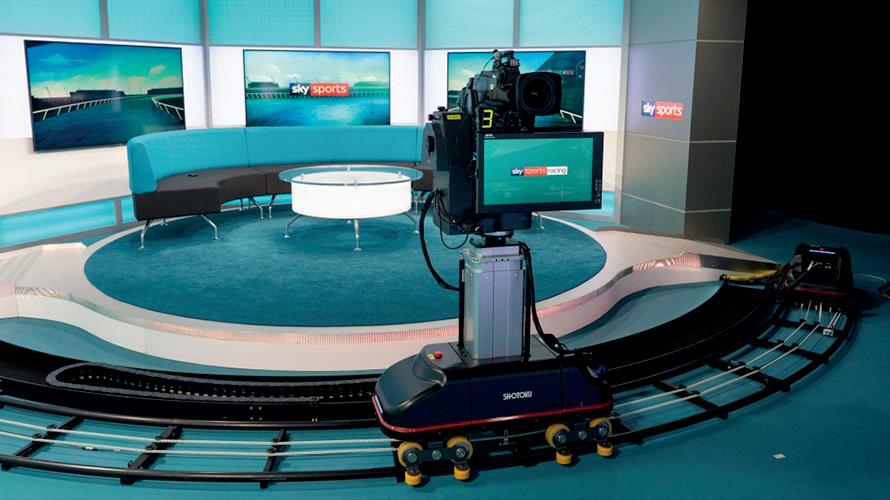
intricate camera movs and capture immersive visuals.
Key features of robotic camera systems
Robotic camera systems
offer several key features that enhance functionality, reliability, and performance in broadcast operations.
Key features include:
- Remote control interface: Intuitive control interfaces allow operators to remotely manipulate camera movement, focus, and exposure remotely. User-friendly interfaces
streamline operation and facilitateseamless integration into broadcast workflows.
- Precision positioning: Robotic cameras are equipped with precision motors and encoders for accurate positioning and smooth motion control. Precision is critical for capturing high-quality images and maintaining consistency in broadcast output.
- Automated presets and tracking: Advanced robotic camera systems
offer preset capabilities and automated tracking algorithms that allow operators to pre-program specific camera movements or autonomously track moving subjects. These features increase efficiency and allow broadcasters to focus on content creation.
- Integration with broadcast systems: Seamless integration with broadcast systems, such as switchers, graphics engines, and automation software is
critical for synchronized operation and streamlined production workflows. Robotic cameras often support standard protocols for interoperability with broadcast infrastructure.
Several manufacturers specialize in the design and manufacture of
robotic camera systems, offering a wide range of products tailored to specific broadcast requirements. Some of the leading manufacturers include:
- Sony: Renowned for its innovative camera technology, Sony offers a comprehensive line of robotic camera systems, including the BRC Series and SRG Series, which are known for their superior image quality, reliability, and advanced features.
- Panasonic: Panasonic’s robotic camera solutions, such as the AW-HE Series and AW-UE Series, combine cutting-edge imaging technology with rugged design to meet the diverse needs of broadcasters, event producers, and AV professionals.
- Canon: Canon’s range of robotic PTZ cameras, such as the CR-N300 and CRN500, exemplify precision engineering and versatility,
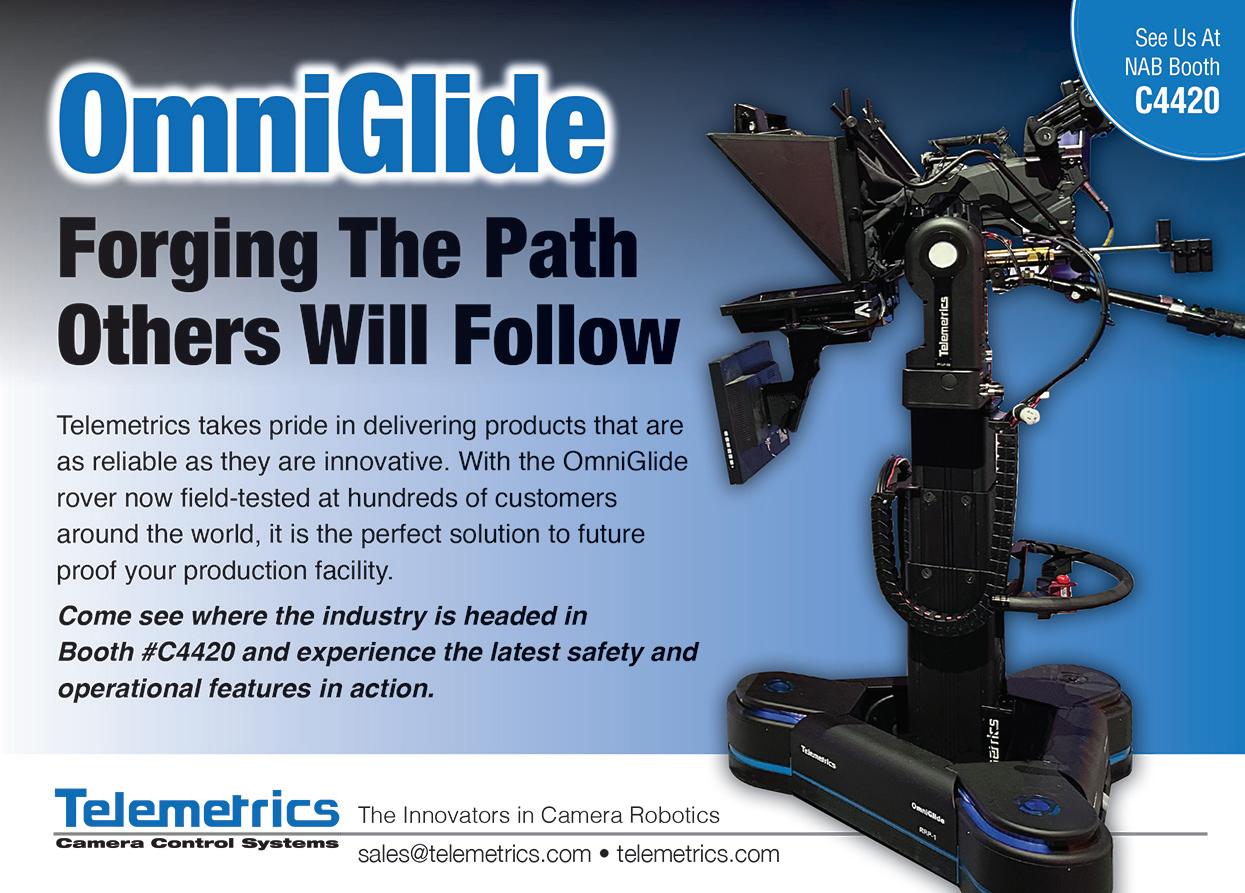
delivering exceptional performance in live production environments, corporate settings, and educational environments.
- Blackmagic Design: Blackmagic Design offers innovative robotic camera systems, such as the URSA broadcast and studio camera series, which are renowned for their integration with Blackmagic’s ecosystem of broadcast products and software solutions.
- Vaddio: Vaddio specializes in the design and manufacture of professional PTZ cameras and camera control systems for broadcast, conferencing, and AV integration. Their products feature advanced image sensors, intuitive control interfaces, and seamless integration with leading control systems, making them a popular choice for a wide range of applications.
- NewTek: NewTek is best known for its TriCaster series of integrated production systems, which include robotic camera control capabilities along
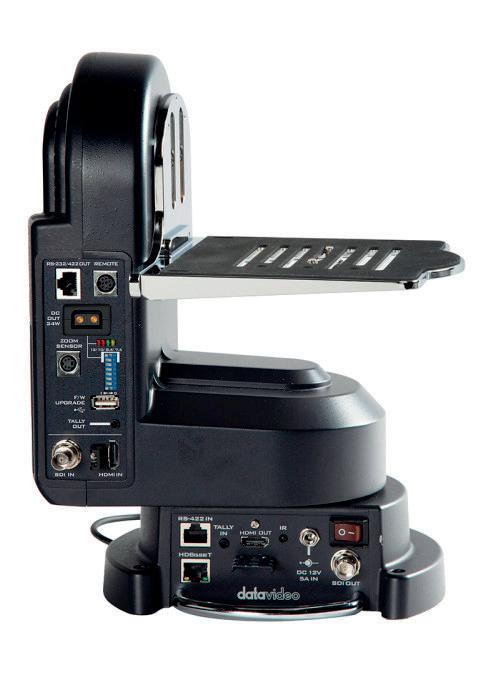
with video switching, graphics, and streaming capabilities. NewTek’s holistic approach to live production enables broadcasters to easily create compelling content by leveraging the seamless integration of hardware and software solutions.
- Datavideo: Datavideo specializes in providing end-to-end solutions for
live video production, including robotic camera systems, switchers, recorders, and streaming encoders. Their robotic PTZ cameras offer professional features such as smooth pan-tilt movements, preset positions, and remote control capabilities to meet the needs of broadcasters, event producers, and AV professionals.
- Telemetrics: Telemetrics is a leading provider of camera robotics and control systems for broadcast, government, and corporate applications. The company’s product portfolio includes robotic camera pedestals, pan-tilt heads, and control panels that enable precise camera movements, tracking, and automation in a variety of production environments.
- Axis Communications: Specializing in network cameras and video surveillance solutions, Axis Communications offers a range of PTZ cameras suitable for broadcast applications. Their networkbased approach to camera technology provides scalability, flexibility, and interoperability, making Axis cameras ideal for integration into existing IP-based broadcast infrastructures.
- PTZOptics: PTZOptics focuses on producing PTZ cameras tailored for live streaming, video conferencing, and broadcasting. Their
cameras feature highquality optics, multiple video outputs, and remote control capabilities, enabling broadcasters to easily capture and stream professional-quality content.
- JVC Professional Video: JVC Professional Video offers a range of robotic PTZ cameras designed for broadcast, sports, education, and corporate applications. The cameras feature innovative imaging technologies, versatile connectivity options, and easy-to-use interfaces, making them suitable for a wide range of production scenarios.
- Lumens Integration: Lumens Integration specializes in providing PTZ cameras and document cameras for educational, corporate, and broadcast environments. Their cameras feature highresolution sensors, fast and quiet pan-tilt movements, and advanced image processing capabilities to deliverexceptional performance and reliability
in demanding production environments.
- Shotoku Broadcast Systems: Shotoku Broadcast Systems specializes in the design and manufacture of robotic camera support systems, including pan-tilt heads, pedestals, and control solutions for broadcast, sports coverage, and live events. With a focus on precision engineering and innovative design, Shotoku’s products offer exceptional reliability, flexibility, and performance in demanding production environments.
- XD Motion: XD Motion specializes in the design and manufacture of advanced stabilized camera systems, including gyrostabilized heads, telescopic camera cranes, and remote camera platforms. With a focus on precision engineering and innovative design, XD Motion products offer unparalleled stability, mobility, and versatility for capturing dynamic imagery in broadcast, sports coverage, and cinematography.
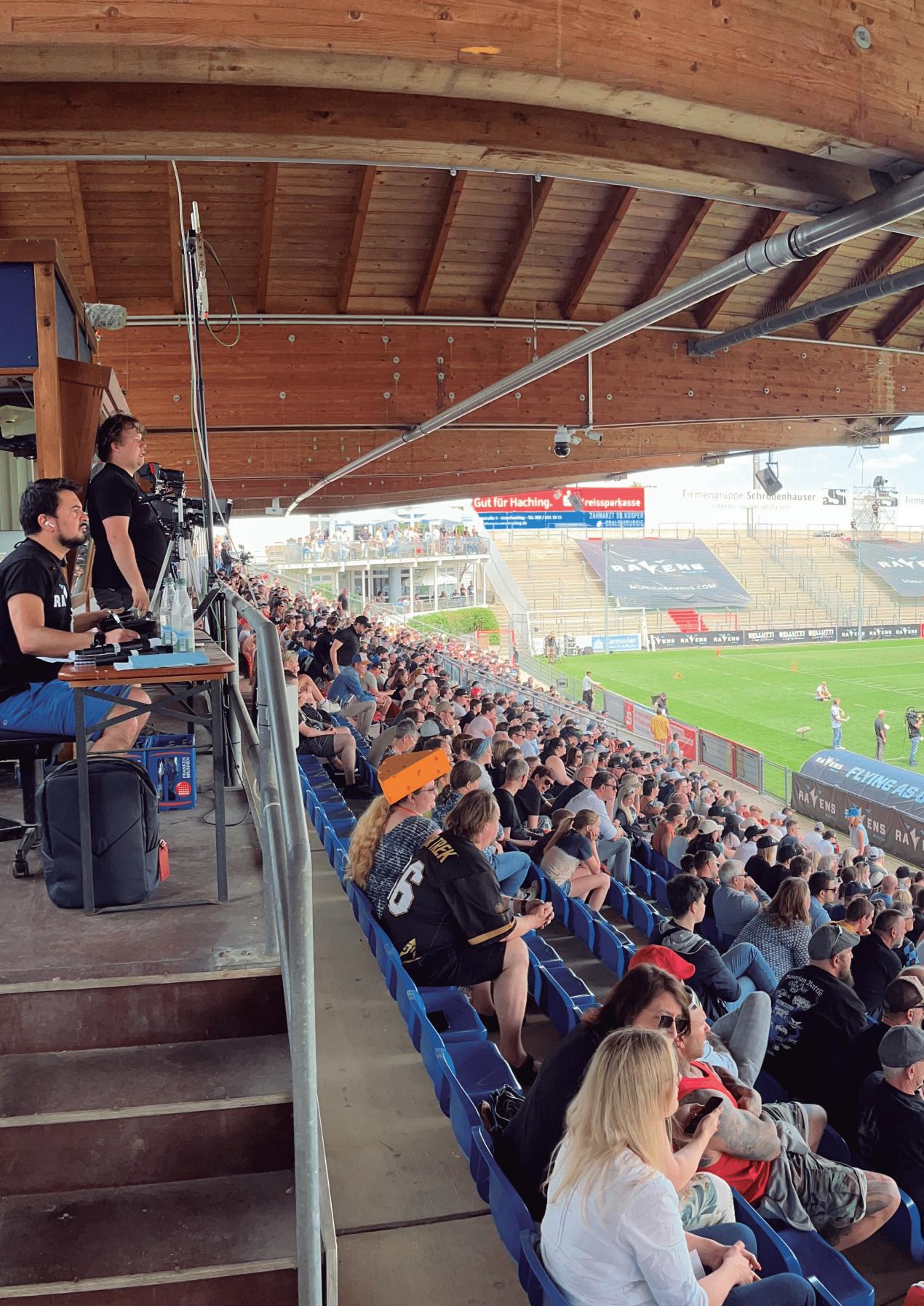
Scoring a touchdown for sustainability and cost savings: How the European League of Football embraced cloud for live production

Vizrt, Novel Media, and Amazon Web Services (AWS) helped the European League of Football save 300 tons of CO2 and nearly €1million in production costs for the 2023 season’s live productions of nearly 100 American Football games
300 tons of CO2 emissions saved ~€1million saved in production costs >100 games produced remotely
Since launching in 2021, the European League of Football has enjoyed a growing fanbase. Playing American Football, 17 teams from Germany, Poland, Spain, Austria, Italy, Switzerland, Hungary, Czech Republic, and France are now part of the League with more teams joining each season.
Growing at an incredible rate, European League of Football viewership is already reaching over half a billion households worldwide through the official ELF Game Pass streaming platform and popular European TV networks.
For the important advertising-relevant target group of 14-49-year-olds, research shows that American Football is now the second most popular sport in Germany – second only to Soccer – having ousted the traditional second-place sports like ski jumping and handball. With similar growth trends expected throughout
Europe, the European League of Football decided to radically improve the viewer experience for the 2023 season by delivering live productions instead of the recorded game footage of previous seasons.
The European League of Football also wanted to make its coverage more relevant and exciting for viewers by offering multi-language commentary options and adding data-driven 3D and augmented reality graphics. For sponsors, they were keen to improve advertising options. The European League of Football was also determined to cut its carbon footprint to be more sustainable, while simultaneously reducing production costs.
The European League of Football realized that moving production to the cloud would make all this possible. So, with

just three weeks to go before the 2023 season kicked off, the European League of Football and its production partner, Munich-based novel. Media, engaged Vizrt and Amazon Web Services (AWS) to help them deliver end-to-end fully cloud live productions.
“When the European League of Football told us they wanted to go completely to the cloud for its 2023 season, I was immediately excited for the

opportunity. We decided to work with AWS and Vizrt to do this transition efficiently and effectively to provide an even better viewing experience for American football fans across Europe,” says Levon Milikian, Managing Director and Founder of novel.media.
“Our challenge was to broadcast more than 100 games in nine countries, wanting to be sure we had the same on-air graphics and quality of production we’ve
been providing the European League of Football for the past two years. Creating a great fan experience for viewers is important, and what we have with football viewers is a love for statistics and information that we broadcast live, which is not easy to achieve. This was particularly difficult because the teams are spread all over Europe, with directors all over Europe as well. We wanted to ensure we had this high standard for everyone working in the production,
“…we wanted to have graphics and virtual logos to increase value for sponsors to the standard that only Vizrt can provide.”
Levon Milikian, Managing Director and Founder of novel.media
all over Europe – and that was only possible with a remote production model.”
To make this vision a reality, Vizrt and AWS proposed an end-to-end cloud setup powered by the Vizrt Live Production Solution, all connected by NDI®, the gamechanging technology that makes cloud live productions possible.

TriCaster® Vectar would provide software-based video/audio switching, with Viz Engine rendering graphics in real-time. Virtual augmented reality (AR) “cam carpet” advertising and 1st and 10th lines would be powered by Viz Arena, while Viz 3Play 3PV guaranteed replay and slow motion, so viewers could catch every moment of the game.
All the Vizrt tools would be deployed into the cloud for each game automatically at
the click of a button, using Viz Now. An automated deployment tool, Viz Now allowed the European League of Football and novel.media to create end-to-end live production capacity in the cloud in minutes, at the click of a button, and gave them easy access to a suite of high-end live production tools usually out of reach of niche sports content creators.
And thanks to Vizrt’s “best-of-breed” interoperability ethos, third-party tools
including Comprimato Live Transcoder (for encoding NDI to SRT for playout) and Tractus MultiViewer for NDI (for viewing up to 16 NDI sources at once) were included in Viz Now’s deployment templates.
AWS services form the infrastructure backbone for the set-up, including Amazon Elastic Compute Cloud (Amazon EC2) which supports productions in a reliable, scalable manner, and AWS S3 for file storage.
Logic Media’s Portal framework would also be used to “spin up” cloud-hosted instances of LiveU encoders and the required AWS services for playout and distribution. Spalk’s Virtual Commentary Studio would provide content localization through multiple language commentary, and LiveU hardware and software would help get the camera feeds into the cloud.
Producing in the cloud live productions proved incredibly cost-effective and carbon-efficient, as it means live productions can be delivered by remote teams, with no need for Outside Broadcast (OB) trucks and large crews to be sent to stadiums with all the expense and emissions that entails.
“When it comes to sustainability, the impact of doing remote productions was huge,” explains Milikian. “We used to have five to six operators every week traveling all over Europe, and a rough calculation now suggests we are saving more than 300 tons of carbon dioxide per season.”
Viz Now was also key to achieving control over cloud costs and carbon emissions, by automating the deployment and shutdown of up to six live production environments on game days. By using cloud and Viz Now, there’s no need to buy and maintain hardware and leave it running 24/7; novel.media
can spin up a cloud-based live production environment when required and switch it off when the game coverage is finished. This means they’re only using the AWS services during production, saving significant costs and carbon emissions.
“With our tight deadline, Viz Now was incredibly important”, says Milikian. “It saved weeks of deployment and setup time, as it automates the deployment into AWS and provides a clear portal to spin up the live production environments on game days and turn them off when games were finished.”
“…we are saving more than 300 tons of carbon dioxide per season”
Levon Milikian, Managing Director and Founder of novel.media
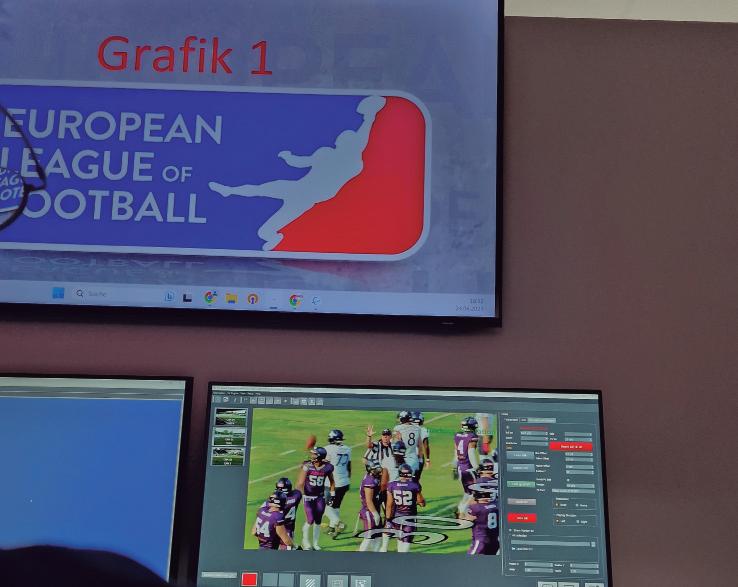
Speaking about overall cost savings, Melikian says: “The benefits were clear, with efficiency improvement being on another level. We can do all the productions in our studios, where we can produce four games in parallel.
“In terms of savings, an almost seven-digit figure per season has been reduced in cost, and considering that this is a young league, this kind of cost reduction while maintaining a high level of production makes a lot of difference in helping them grow. We managed to reduce costs significantly while still using up to seven cameras on the field in parallel, and that of course improves the fan experience, with every angle of the game covered.”
For novel.media operators working in this cloud-based production environment, latency is no different than if they were connected to an on-premises system. An operator in the Munich office who presses a button on their control panel connected to TriCaster Vectar in the cloud will see a change in under half a frame.
Furthermore, a program feed with virtual advertising and the 1st and 10th lines added by Viz Arena can be sent back to a European League of Football match stadium via the cloud for display on the audience’s big screen with no noticeable delay from the real-time game action.
• Before matches begin, the Admin Service Manager at novel.media spins up the cloud-based live production environments using Viz Now. This brings all the Vizrt tools online as well as the 3rd party elements.
• Then Logic Media’s automated deployment tool, Portal, is used to spin up the virtualized LiveU LU4000 units and all the AWS services required for transcoding and distribution such as AWS Elemental MediaConnect, AWS Elemental MediaConvert, and Amazon S3.
• In the stadiums, there are up to seven cameras on the ground with four novel. media camera operators shooting the action.
Two LiveU LU800 field units convert the SDI camera feeds to LiveU Reliable Transport (LRT) 1080p50 HEVC signals and transmit them to AWS over 4G or 5G.
• In the cloud, these LRT signals are decoded to NDI using virtualized LiveU LU4000 units where they pass into all the Vizrt tools for the live productions.
• From four control rooms in their Munich office, novel.media operators remotely access the Vizrt live production tools such as TriCaster Vectar, Viz Engine,
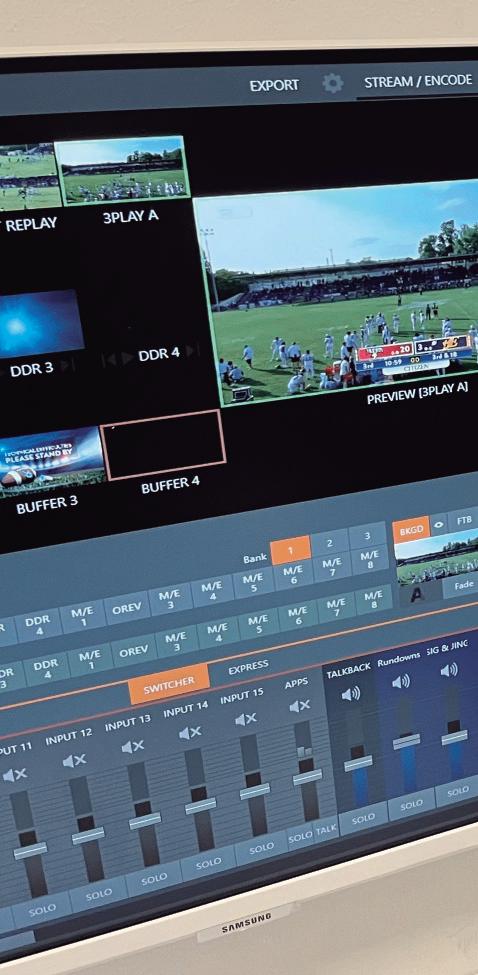
and Viz 3Play 3PV via AWS’s remote display protocol NiceDCV.
• Operators from OnAir-Graphics access and control Viz Arena from novel.media’s offices, using data generated during the game to add augmented reality graphics and the virtual 1st and 10th lines and to display virtual “cam carpet” ads.
• To make the content relevant for fans, cloud switching tool TriCaster Vectar produces two NDI outputs: a graphics-
only version of the world feed designed for local broadcasters to insert presenters and L-frames themselves; a second output is available for the ELF Game Pass platform which features European League of Football, Czech, or Polish presenters.
• Comprimato then encodes these two outputs into SRT signals and passes them to third-party commentary provider Spalk where commentary is added for up to seven languages for audio localization. Each
language then becomes a separate single language SRT signal which is passed through to Logic Media’s transcoding and distribution system in AWS, where they are distributed for OTT, VOD, and linear playout.
• Once the games have finished, novel.media’s Admin Service Manager uses Viz Now and Logic Media’s Portal to close the cloud-based production environment until it is next needed – cutting down running costs and carbon emissions at the same time.
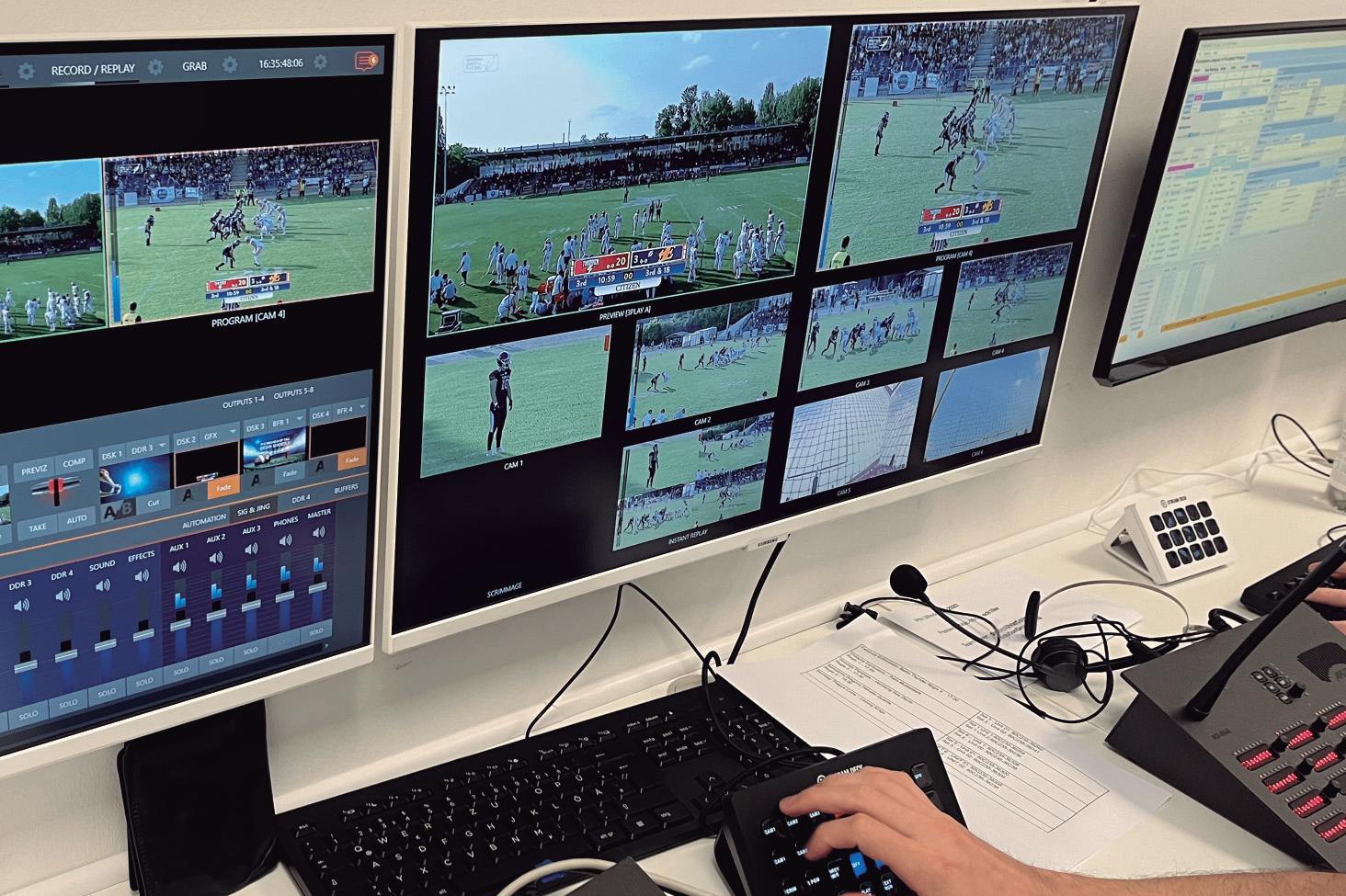
Not long ago the amount of equipment and crew required to produce live sports put it financially out of reach for niche sports. However, the cloud now makes it possible for growing sports federations like European League of Football to deliver live action to their fans in true broadcast quality. The flexibility of cloudbased production also means they can test new workflows and tools.
“What the European League of Football has achieved in just three weeks with AWS and Vizrt is incredible, and a testament to the power of the cloud,” says Marc Aldrich, General Manager, Global Media & Entertainment at AWS.
As the founders of NDI, Vizrt’s cloud live production tools will have native use of the HDR support in NDI 6, so that the European League of Football and other content creators will be able to deliver live content in glorious HDR.
Nick Mariette, Director of Product Management for NDI, explains: “With NDI 6, the next update coming to our core technology, the
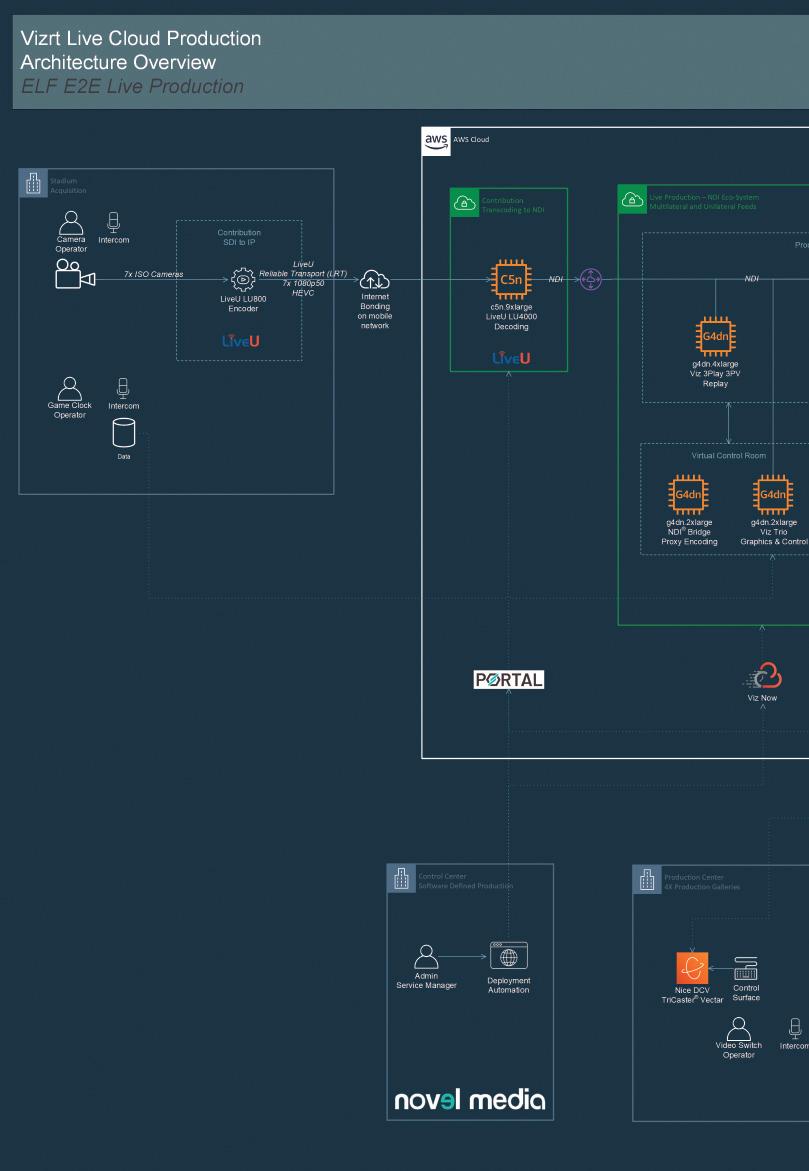
addition of HDR support confirms that NDI is up to the quality standard professional live broadcasting requires. And that’s just one of the
upcoming enhancements that will change how NDI is used, not only in broadcasting and ProAV but even in further industries.”

Commenting on the success of the project, Melikian said: “Our goal was to make a smooth transition to cloud production without losing the
high quality of broadcast the fans were expecting. We were also looking to improve viewer experiences, and the new features that the Vizrt Live
Production Solution offered with advanced graphics and increased video quality, gave us what we needed to take that step.”
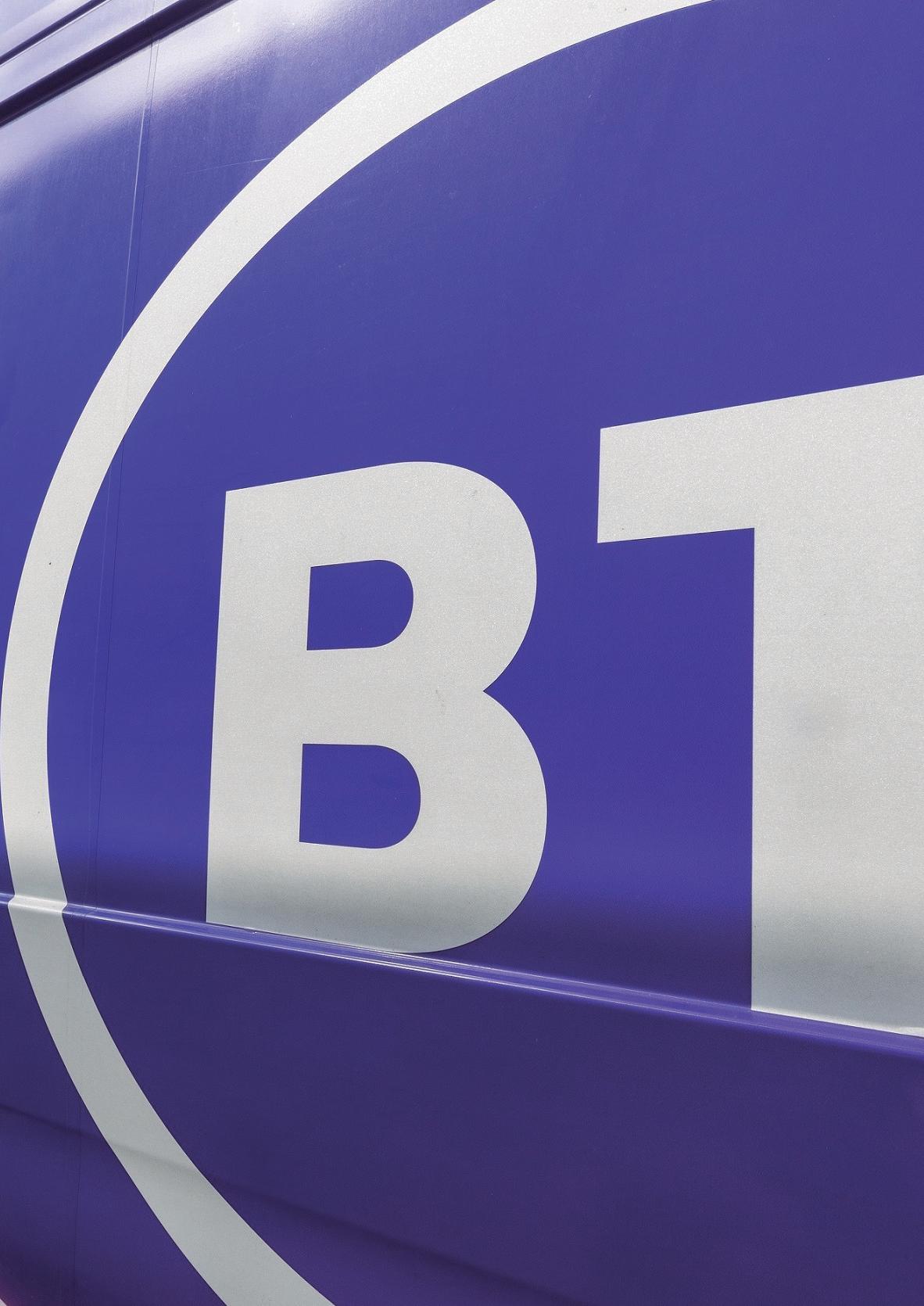
Boosting live coverage with cutting-edge technologies

In the fast-paced world of broadcast media, BT Broadcast & Media stands as a beacon of innovation and versatility, navigating the complex terrain of live event coverage with remarkable dexterity. From the electric atmosphere of t op-tier football matches to the grandeur of international sporting events like the Commonwealth Games and UEFA Champions League Finals, BT has seamlessly integrated cutting-edge technology with traditional broadcast infrastructure, bringing unparalleled viewing experiences to audiences worldwide. Their recent undertakings, including coverage of significant cultural moments such as the King’s Coronation and the Queen’s Funeral, further demonstrate their capacity to handle a diverse array of events with finesse and sensitivity.

Delving deeper into the technological prowess behind the scenes, BT’s adeptness in remote production solutions emerges as a game-changer in the industry. The company’s strategic approach, particularly during the challenges posed by the confinement, underscores their commitment to innovation, sustainability, and quality. By deploying solutions like the Project Restart, BT not only facilitated the return of the English Premier League to screens across the UK but also set a new standard for remote production, balancing technical excellence with social responsibility.
Looking ahead, BT’s forward-thinking strategies, especially in the realm of 5G private network solutions, are poised to redefine the boundaries of broadcast and media production. As the industry gears up for landmark events like the 2024 European Championships and the Paris Olympics, BT’s involvement promises to bring about a new era of connectivity, agility, and quality in live broadcasting. Their relentless pursuit of excellence, coupled with a keen eye on emerging technologies such as AI and cloud integration, positions BT Broadcast & Media at the forefront of a revolution that is set to transform how we consume live content, making it more immersive, accessible, and engaging than ever before. With this interview, TM Broadcast International takes its readers to the future of Remote Production, together with Dom Wrona, Head of Portfolio & GTM in BT Media and Broadcast.
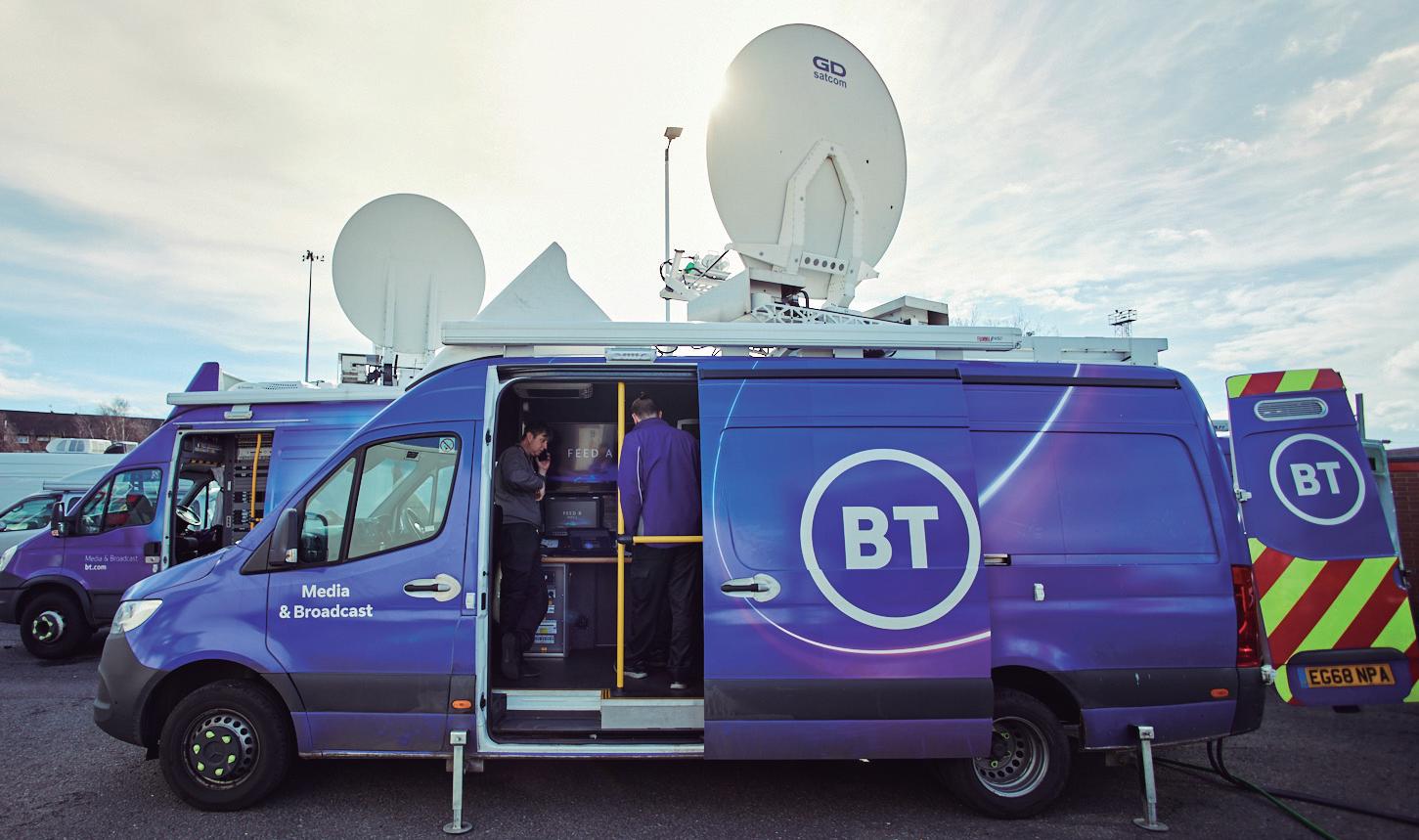
What major sporting events has BT M&B covered / produced recently?
We offer a diverse product set to support a wide range of events for customers. From our fixed infrastructure like our intelligent media platform, Vena, accommodating broadcasters such as BBC and ITV, to our market leading Outside Broadcast portfolio, some of the highlight events have included:
• Top tier football in the UK: English Premier League, Scottish Premierships and UEFA European football matches held in the UK
• Rugby and Horseracing, including Royal Ascot, the Six Nations Championship and Premiership Rugby
• Commonwealth Games and UEFA Champions League Finals.
• In addition to sports, we have also covered major events such as the King’s Coronation and the Queen’s Funeral, as well as events including the World’s First AI Safety Summit at Bletchley Park.
How does BT Media and Broadcast’s remote production equipment integrate with existing broadcast infrastructures of clients?
We understand that when you operate with such a wide customer base, there will be different ways of operating and very different requirements. We have to be
able to accommodate customers that, for example, only want EVS control to be remote versus a customer that wants the entire event produced from a centralised location. When we offer our solutions, we tend to do so end to end. This not only allows us to offer greater reliability, but also mitigates any issues we could have with integration. When we are required to integrate our products and services with existing broadcast infrastructure, we collaborate very closely and apply our strict testing protocols to ensure all a spects of the workflow meet the high standards that both ourselves and our customers would expect.
What challenges have you encountered in deploying remote production solutions, and how have you addressed them?
In my view you can compartmentalise those challenges into two groups:
1. Technical challenges; such as latency, quality and reliability.
2. Social challenges; such as sustainability, work-life balance and inclusivity.
We deployed our Project Restart remote production solution during the Covid-19 pandemic in remarkable speed in order to accommodate all broadcasters in the UK to bring the English Premier League back to the screens at home. This was just the start of our journey and for many of our customers and partners.
Technical challenges were addressed via our highly talented teams, designing a solution with the right infrastructure to keep risk to a minimum, but also to give our customers the flexibility they needed - whether that’s the vendor we have picked to deploy a solution, bandwidth capacity or compression levels. In terms of the social aspects, those tend to be
multifaceted. At first, the obvious assumption was that remote production reduces carbon footprint - but since then there has been interesting debate about how this can be dependent on how the solution is deployed. We believe that remote production creates a far more inclusive work environment for employees that may not be able to travel each weekend up and down the country, but on the flipside there is also a large pool of individuals who absolutely love that aspect of the job and therefore finding the right balance is critical. And we trust our customers/partners to do so – we want to give them that choice and flexibility.
Can you describe the specific features and capabilities of your 5G private network solutions tailored for the broadcast and media industry?
• We can support large-scale productions outside of the studio.
• Our 5G Rapid Response Vehicle (RRV) offers reliability, an uncontended network with bespoke coverage, ensuring throughput for image acquisition even in crowds.
• Fast, low latency connectivity enabling improved interactivity between studio and field, facilitating natural conversation.
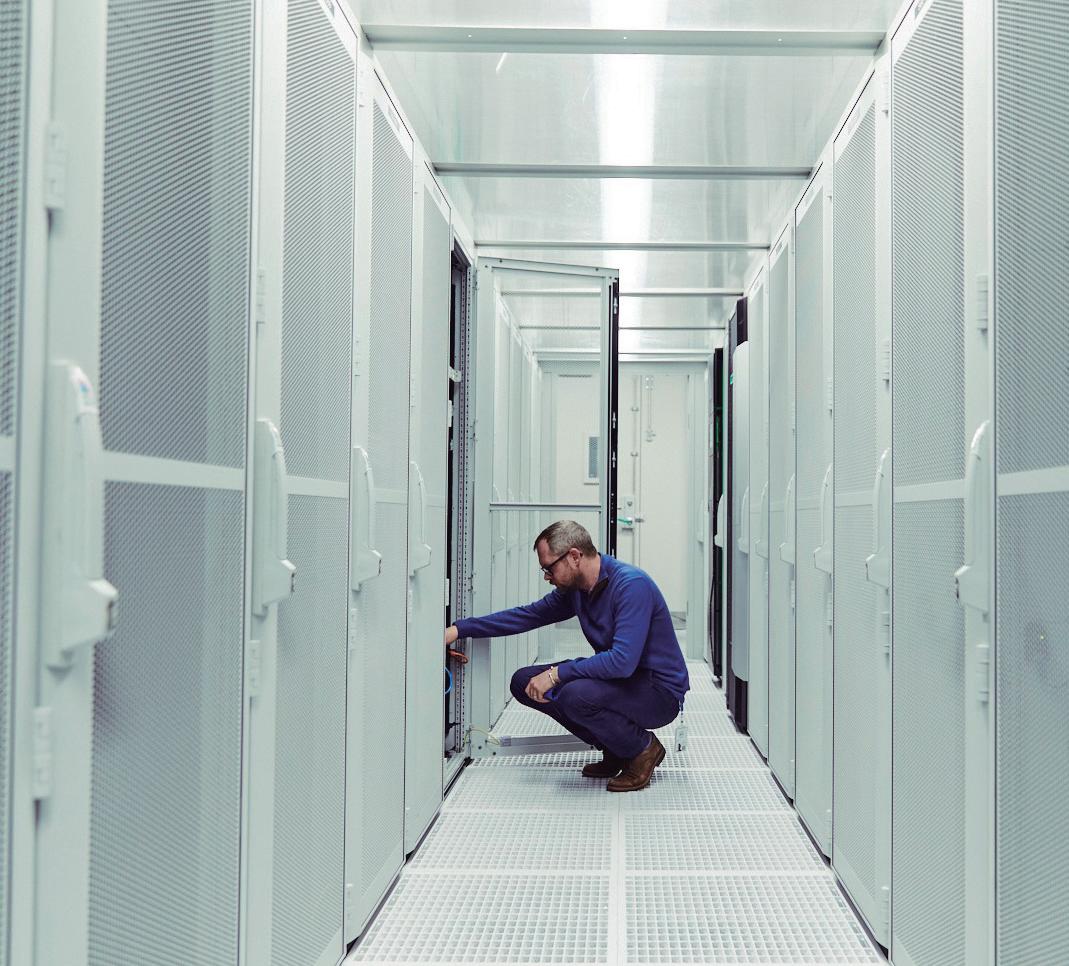

• Production quality – low latency and high bandwidth allows studio level production features such as superimposed elements.
• Immediate deployment with fast set-up. Our RRV is a 4x4.
• A range of backhaul offerings including GEO Satellite, Fibre, LEO, and Microwave.
• It uses licenced spectrum N77 to ensure content is not affected by the consumer 5G network.
• Promotes Agility and Flexibility.
• Decreased deployment of staff to site, lower resource dependency which can lead to lower associated costs.
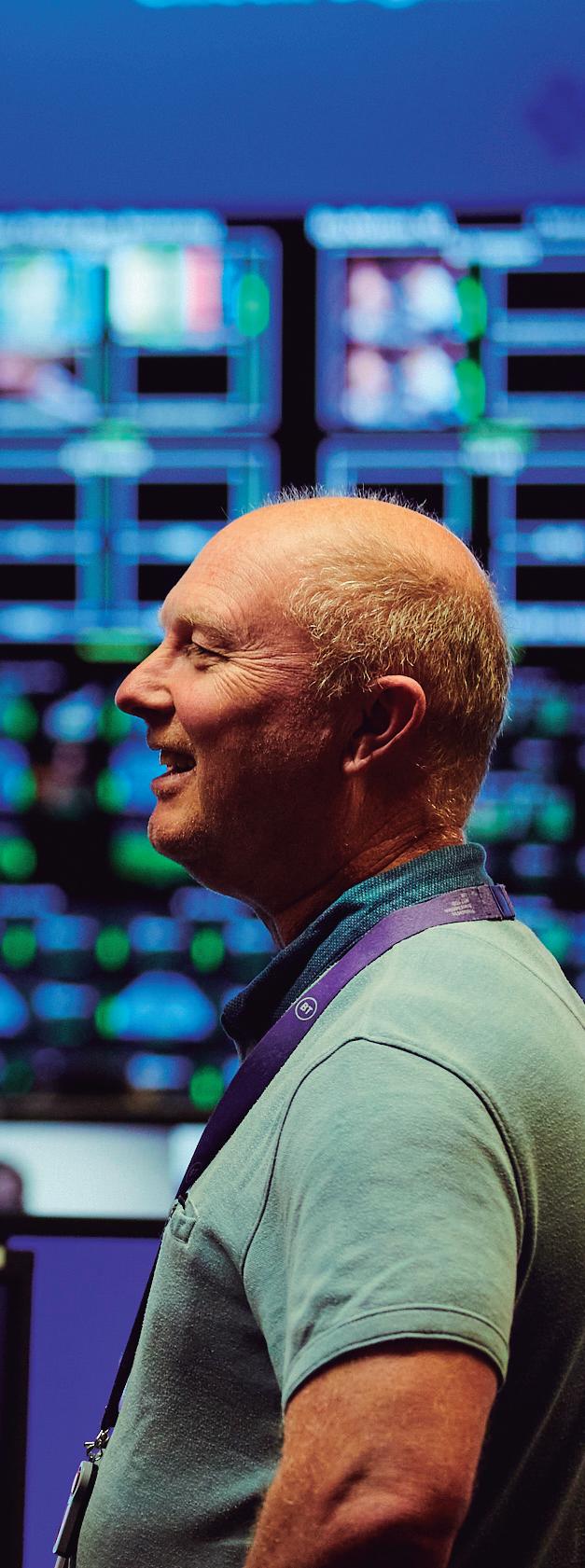
• A 5G private network can be connected directly into backhaul connectivity, meaning there can be highly limited production presence on site and camera feeds can be sent directly back to
a ROC, with return vision, communications, tally and camera control being enabled too.
In 2024, which major sports tournaments or competitions will be most important or have the greatest impact on the industry?
We are very fortunate in 2024 where the European Championships and Olympics are happening during the same summer. Very often the risk appetite to implement new technology at events of this size is minimal. However, there always is an aspect of the production, contribution or distribution where an innovative solution is deployed. I believe that we will yet again see something special at the Olympics and/or Euros. We will be involved with both…
How will BT M&B be involved in the upcoming Paris Olympics?
We will be providing an end-to-end managed solution guaranteeing content delivery back to the UK and for onward distribution. We will be working on behalf of a major UK broadcaster, with presence on site and deployment of our Outside Broadcast capabilities.
Looking towards the future, what emerging technologies or trends do you see playing a signi fi cant role in broadcast and media production, and how is BT Media & Broadcast preparing to integrate them into your solutions?
There are some obvious choices such as Cloud integration and how we make the most from it; 5G and ability to network slice in order to ful fi l the full potential of the capability; but also the hot buzz word of AI - it will be interesting to see how that develops and what role it can play in our sector.
What is critical for us at BT is that we continue to innovate at the epicentre of the eco system. Aggregating the latest technology, implementing it, driving internal and external innovation for the bene fi t of our customers. We have a long history of world fi rsts and innovation and the driving ambition is always to create solutions and services for our customers that will help them become faster, better and more e ffi cient.
